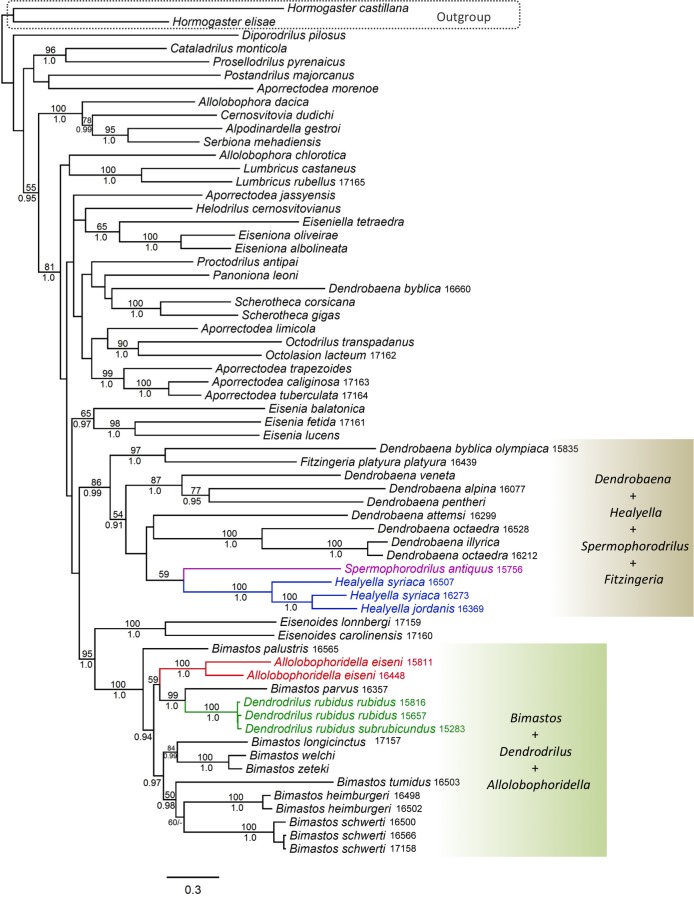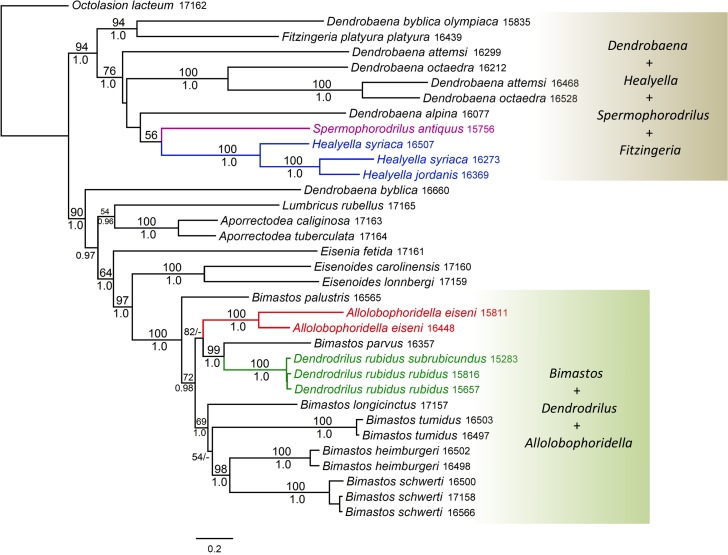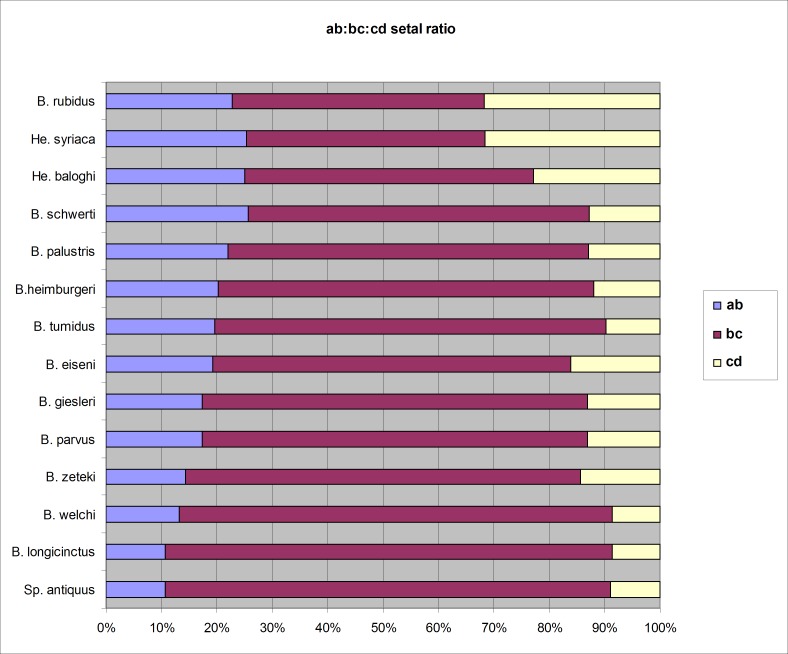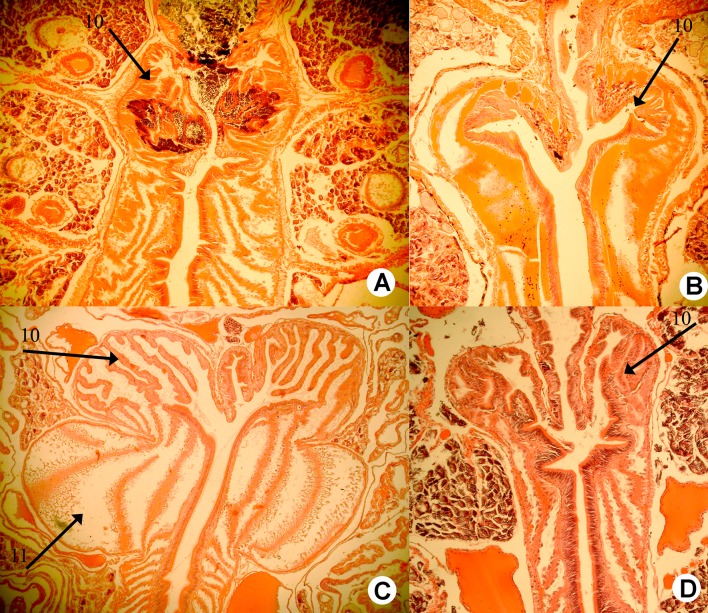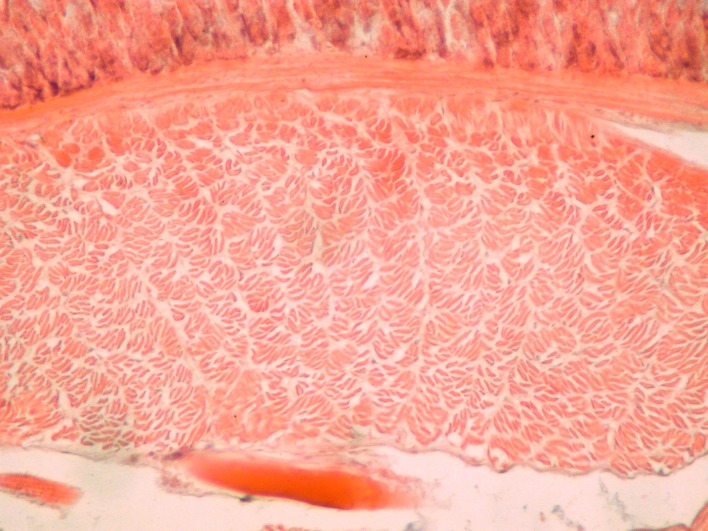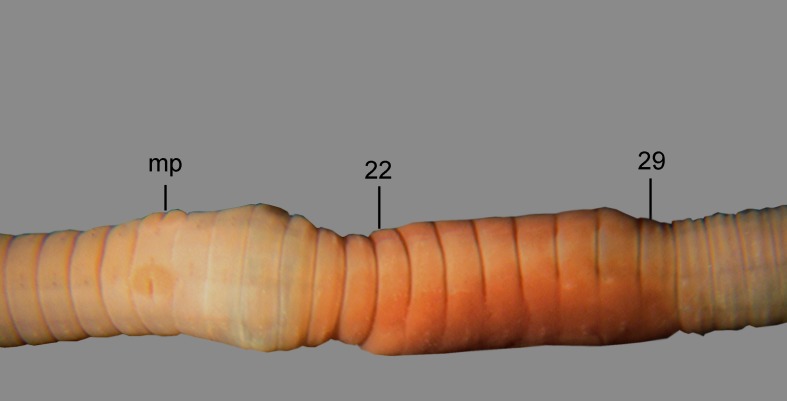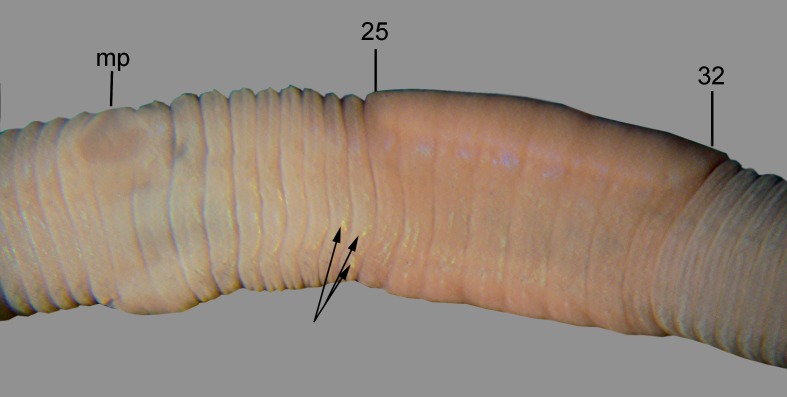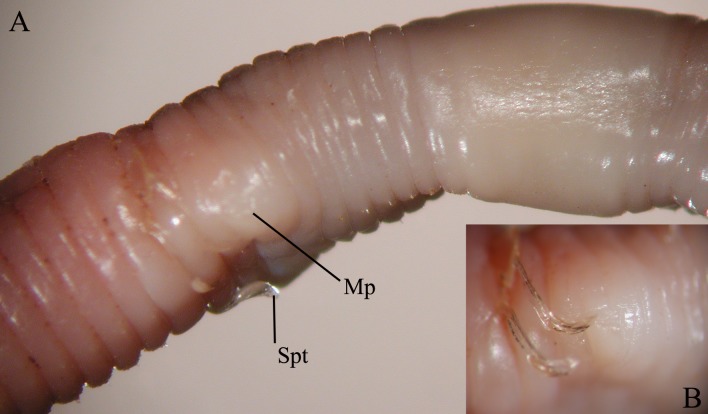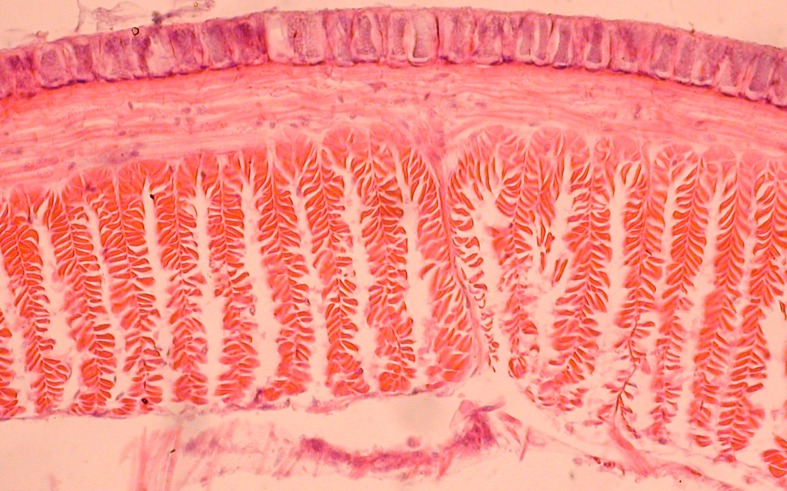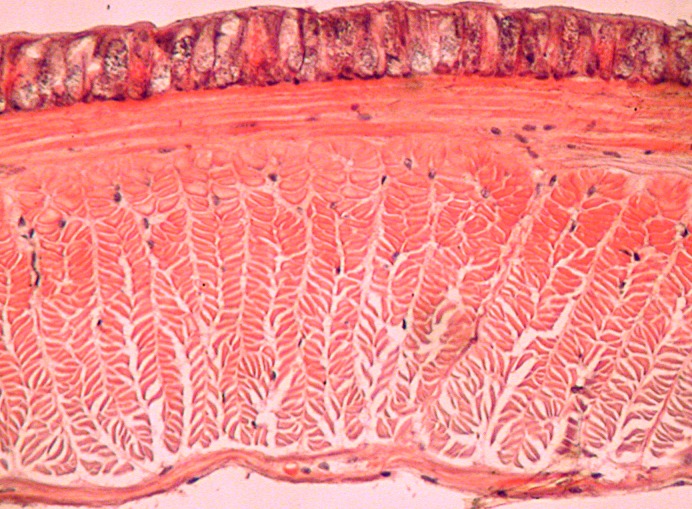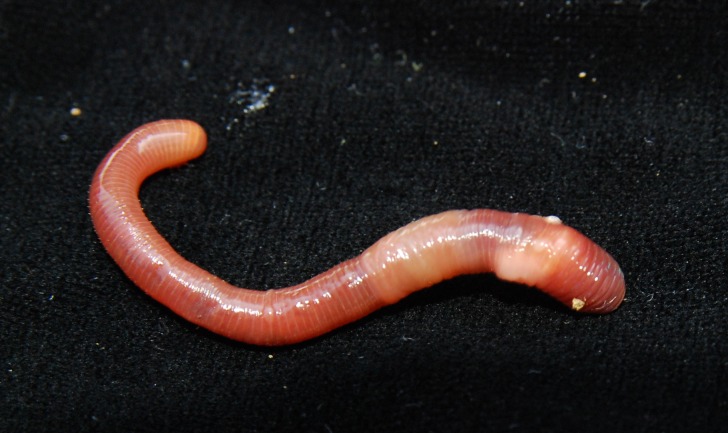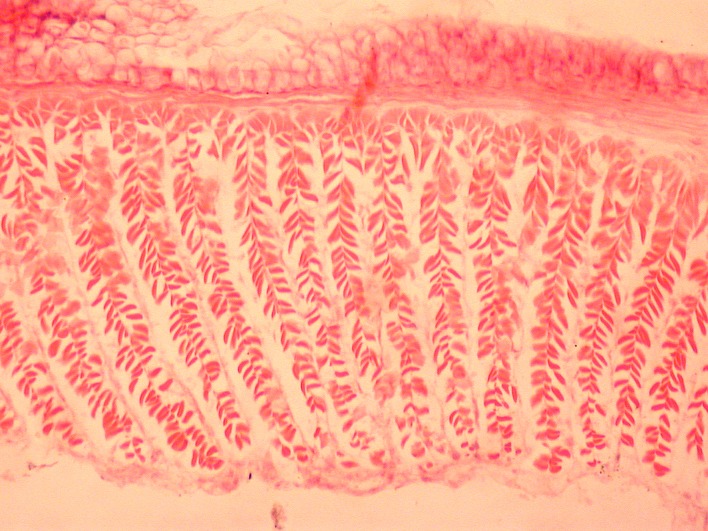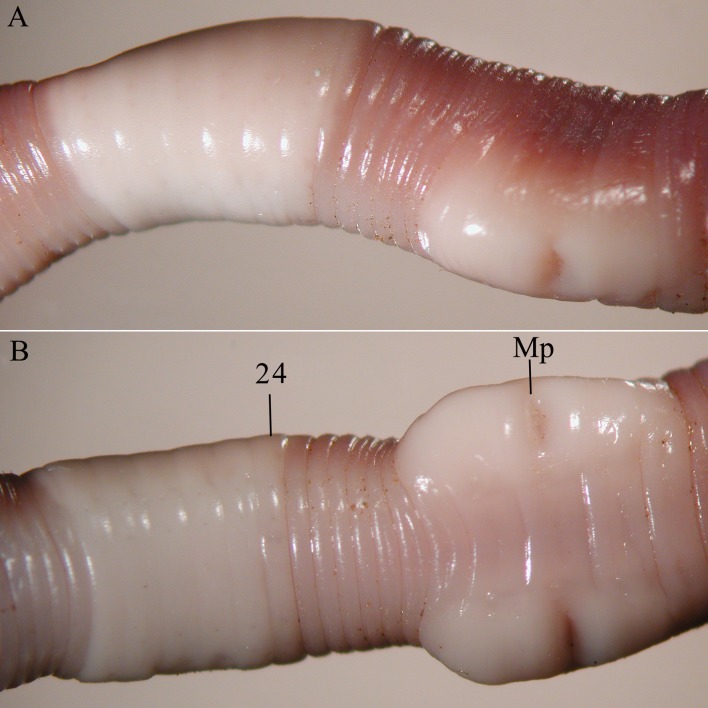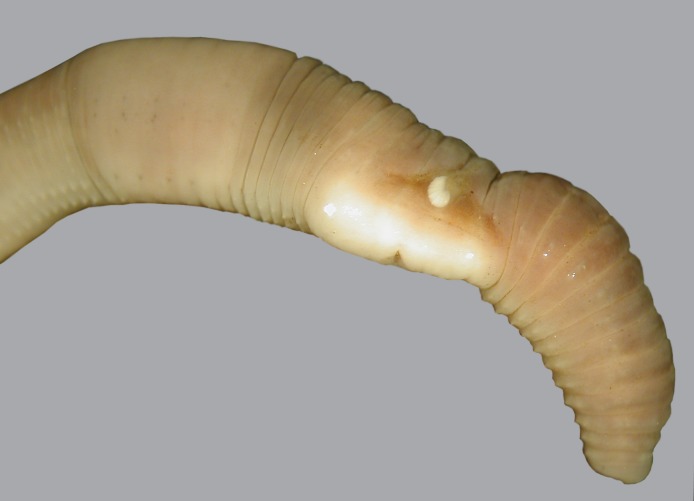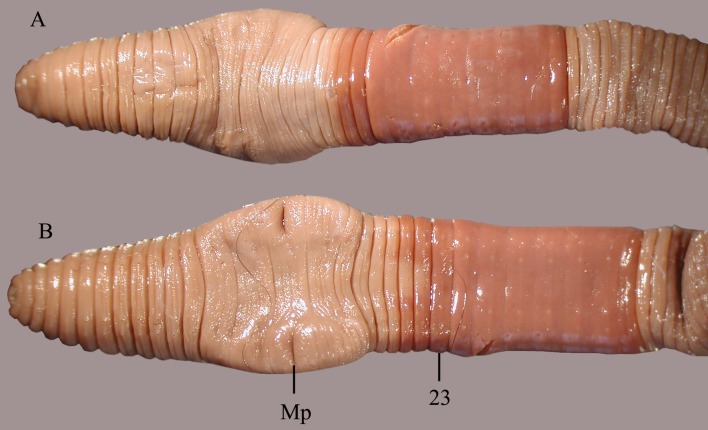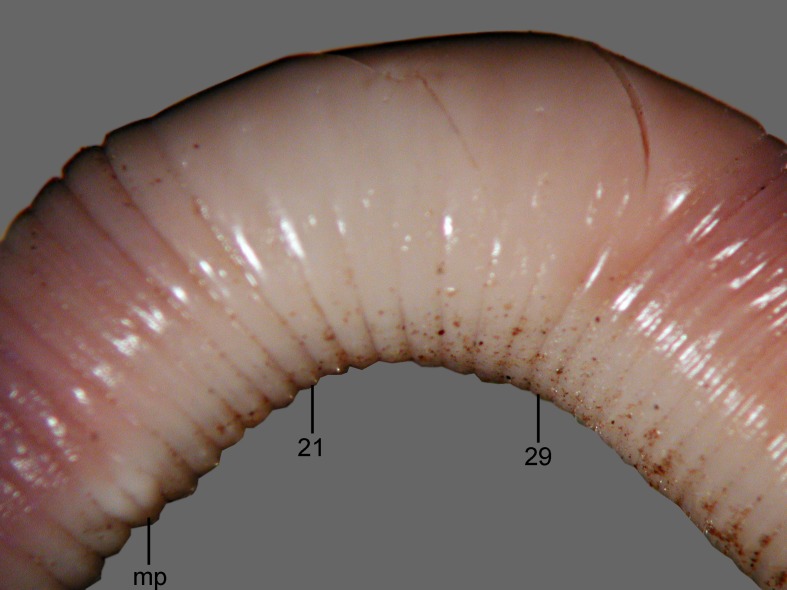Abstract
The family Lumbricidae is arguably the most well-known and well-studied earthworm group due to its dominance in the European earthworm fauna and its invasion in temperate regions worldwide. However, its North American members, especially the genus Bimastos Moore, 1893, are poorly understood. We revised the systematics of the genus Bimastos and tested the hypothesis of the monophyly of North American lumbricids using morphological characters and eight molecular markers. Phylogenetic analyses based on our extensive sampling of Bimastos and inclusion of Dendrodrilus and Allolobophoridella indicated a well-supported clade containing Bimastos and Eisenoides Gates, 1969, and provided the first evidence supporting that North American lumbricids are monophyletic. Assuming the available divergence time estimations and dating of land bridges are correct, it would suggest that the ancestor of this clade arrived North America through Beringia or the De Geer route during Late Cretaceous, and since then the clade has diverged from its Eurasian sister group, Eisenia. The peregrine genera Dendrodrilus and Allolobophoridella are nested within the Bimastos clade; we propose to treat them as junior synonyms of the genus Bimastos, and, contradictory to the commonly held belief of being European, they are indeed part of the indigenous North American earthworm fauna. Morphological characters, such as red-violet pigmentation, proclinate U-shaped nephridial bladders and calciferous diverticula in segment 10 further support this placement. The East Mediterranean–Levantine Spermophorodrilus Bouché, 1975 and Healyella Omodeo & Rota, 1989 are nested within the Dendrobaena sensu lato clade; therefore their close relationship with the North American Bimastos is refuted. Species fit the revised diagnosis of Bimastos are reviewed and keyed, and a new species, Bimastos schwerti sp. nov., is described.
Introduction
Earthworms of the family Lumbricidae are native to the Holarctic. They represent a keystone group of macrofauna in temperate soils, with about 30 common species spread globally by human activity [1]. The family currently has around 750 described species within approximately 40–60 genera [2–4]. While the majority of the species and genera are native to the Palearctic region, two genera, Bimastos Moore, 1895 and Eisenoides Gates, 1969, are generally believed to be native to North America [5], with nine and two described species, respectively. In the USA, species belonging to the two genera frequently co-occur with introduced European lumbricids, such as Lumbricus rubellus, Aporrectodea caliginosa, and Octolasion cyaneum [6–8], but usually at lower abundance.
The validity, taxonomic boundary and origin of Bimastos, aptly called a “systematic wastebasket” by Gates [9], have been widely debated [5, 10–16]. Taking into account previously overlooked morphological characters, including the shape and orientation of nephridial bladders and the structure and position of calciferous glands, Gates [5] argued that the name Bimastos should be restricted only for North American species. This concept of Bimastos was later supported by Omodeo and Rota [14], who separated the Balkanic and Anatolian Spermophorodrilus Bouché, 1975 and Healyella Omodeo & Rota 1989 from North American Bimastos. However, Omodeo and Rota’s concepts of the three genera suffered severely from ambiguous morphological descriptions and overlapping diagnosis. For this reason, Zicsi [13, 15] concluded that the three genera form a homogenous group, and both Spermophorodrilus and Healyella are junior synonyms of Bimastos. In contrast to Gates’ restricted definition of Bimastos to the Nearctic, Zicsi’s concept of Bimastos encompasses species not only from North America but also from the Balkans and the Anatolia, thus creating a biogeographic puzzle with questions on how this genus achieved its current native range of distribution.
The biogeographic puzzle concerning the two competing hypotheses of Bimastos is further complicated by the close affinity among Bimastos and two monotypic genera, Allolobophoridella and Dendrodrilus [17, 18]. This affinity has been suggested in preliminary molecular analyses [19, 20], and was recently confirmed in the multigene molecular phylogeny of Lumbricidae [21]. The genus Allolobophoridella was created to host two enigmatic species, Lumbricus eiseni Levinsen, 1884 and Allolobophora parva Eisen, 1874 [17]. The latter was soon transferred to Bimastos [3], making Allolobophoridella monotypic. In the past few decades, Allolobophoridella eiseni has been moved around among Allolobophora [22], Eisenia [15], and Bimastos [18] and has also been suggested to show affinities with several Dendrobaena species [23]. Clearly, a phylogenetic re-evaluation of the species and the status of the genus Allolobophoridella were urgently needed.
While morphological similarities, such as proclinate U-shaped nephridial bladders, and Nearctic distributions imply that Bimastos and Eisenoides may be closely related, a hypothesized North American clade composed of only Bimastos and Eisenoides were put through a formal test only recently. Molecular phylogeny of Lumbricidae constructed by Dominguez et al. [21] showed that the North American Bimastos is monophyletic, and is nested within a clade consisting Bimastos, Dendrodrilus, and Allolobophoridella, with the former two genera being the sister groups of each other. While the hypothesis that Eisenoides is closely related to the aforementioned clade gained some support in Dominguez et al. [21], the inferred phylogeny did not support a strict Bimastos-Eisenoides monophyly. Moreover, the result was insufficient for making definitive inferences regarding the status of Bimastos, Healyella, and Spermophorodrilus as only three out of the nine nominal species of Bimastos were included, and the genus Spermophorodrilus and the type species of Healyella were missing from the analyses. Nevertheless, the molecular phylogenetic study of Lumbricidae by Dominguez et al. [21] provided a solid basis for further analysis.
Here we report on a detailed morphological and molecular analysis of Bimastos and related genera. Our objectives were to (1) evaluate the monophyly of North American lumbricids, (2) test the two competing hypotheses of Bimastos outlined by Gates (1969) and by Zicsi (1981), (3) investigate the phylogenetic position of the genera Allolobophoridella, Dendrodrilus, Spermophorodrilus, and Healyella, and (4) conduct a full revision of the genus Bimastos. We integrated morphology with the multigene-phylogeny approach [24–28], using both nuclear and mitochondrial genes to acquire a concatenated sequence length of 5715 bp. We expanded sampling of Bimastos from three to eight species and included the type species of all of the concerned genera, including Allolobophoridella eiseni, Bimastos palustris, Dendrodrilus rubidus rubidus, Eisenoides lonnbergi, Healyella syriaca, and Spermophorodrilus antiquus.
Materials and methods
Specimens
Between 2000 and 2015 we collected in Turkey, the Levant, Middle East, and in the mid-Atlantic region of North America. We also examined the Bimastos collection in the National Museum of Natural History in Washington D.C., where several type specimens are kept, as well as the materials in the Hungarian Natural History Museum where several Healyella and Spermophorodrilus species are housed. Earthworms were collected by both the diluted formalin method [29] and by digging and hand searching. Specimens were killed in 75% ethanol and fixed in 4% formalin then transferred to 75% ethanol after several days. Specimens used for molecular analysis were preserved in 96% ethanol without formalin fixation. All of the specimens collected and/or examined are permanently archived at either the National Museum of Natural History, Smithsonian Institution (USNM), Washington D.C., USA or the Soil Zoology Collection of the Hungarian Natural History Museum (HNHM), Budapest, Hungary. The detailed catalog numbers of specific specimens sequenced can be found in Table 1. For morphological analysis the following specimens were examined: Allolobophoridella eiseni 17 specimens (HNHM/12484, HNHM/14565, HNHM/14743); Dendrodrilus rubidus 15 specimens (HNHM/14185, HNHM/14228, HNHM/14445, HNHM/15283, HNHM/16384, HNHM/6519); Spermophorodrilus antiquus 10 specimens (HNHM/8857, HNHM/9247, HNHM/15756, HNHM/15819, HNHM/15840); Healyella syriaca 16 specimens (HNHM/11131, HNHM/12169, HNHM/14045, HNHM/15141, HNHM/16507); Healyella jordanis 14 specimens (HNHM/12914, HNHM/12915, HNHM/12918, HNHM/14620); Bimastos gieseleri 11 specimens (USNM 25848); Bimastos heimburgeri 44 specimens (USNM 123883, USNM 123879, HNHM/14186, HNHM/14906, HNHM/16498, HNHM/16502); Bimastos longicinctus 64 specimens (USNM 24599, USNM 25871, USNM 47867, HNHM/17151); Bimastos palustris 34 specimens (HNHM/13039, HNHM/14183, HNHM/14189, HNHM/14215, HNHM/14224, HNHM/14227); Bimastos parvus 10 specimens (HNHM/14301, HNHM/14886, HNHM/15170, HNHM/16067, HNHM 16464); Bimastos schwerti Holotype (HNHM/16614) Paratypes 39 specimens (HNHM/16615, HNHM/14184, HNHM/4188, HNHM/16500, HNHM/16510, HNHM/16566, HNHM/16567, HNHM/17158); Bimastos tumidus 55 specimens (USNM 1164, USNM 123878, USNM 123889, USNM 25848, USNM 19683, HNHM 14193, HNHM/14198,. HNHM/16503, HNHM/16497); Bimastos welchi one specimen (USNM 16782); Bimastos zeteki eight specimens (USNM 16782, USNM 26214, USNM 123897, USNM 123898).
Table 1. Specimens newly collected for phylogenetic analyses and their Hungarian Natural History Museum catalog numbers (HNHM).
| Species | HNHM | Locality |
|---|---|---|
| Allolobophoridella eiseni | 15811 | Koula Mts., Greece |
| Allolobophoridella eiseni | 16448 | Col d'Aspin, France |
| Aporrectodea caliginosa | 17163 | Mayo Beach Park, MD, USA |
| Aporrectodea tuberculata | 17164 | Mayo Beach Park, MD, USA |
| Bimastos heimburgeri | 16498 | Gunpowder Falls, USA |
| Bimastos heimburgeri | 16502 | Smithsonian Environmental Research Center, MD, USA |
| Bimastos longicinctus | 17157 | Game land 242, Siddonsburg PA, USA |
| Bimastos palustris | 16565 | Jug Bay Wetlands Sanctuary, MD, USA |
| Bimastos parvus | 16357 | Wadi Kelt, Israel |
| Bimastos schwerti | 16500 | Jug Bay Wetlands Sanctuary, MD, USA |
| Bimastos schwerti | 16566 | Jug Bay Wetlands Sanctuary, MD, USA |
| Bimastos schwerti | 17158 | Game land 242, Siddonsburg, PA, USA |
| Bimastos tumidus | 16497 | Gunpowder Falls, USA |
| Bimastos tumidus | 16503 | Smithsonian Environmental Research Center, MD, USA |
| Dendrobaena alpina | 16077 | Radjuva Planina, Bulgaria |
| Dendrobaena attemsi | 16299 | Socolau Valley, Maramures, Romania |
| Dendrobaena attemsi | 16468 | Palmeira de Faro, Portugal |
| Dendrobaena byblica | 16660 | Kakopetros, Crete, Greece |
| Dendrobaena byblica olympiaca | 15835 | Peristeri, Greece |
| Dendrobaena octaedra | 16212 | Treskovac Mts., Montenegro |
| Dendrobaena octaedra | 16528 | Payolle Valley, France |
| Dendrodrilus rubidus rubidus | 15657 | Cerová Highlands, Slovakia |
| Dendrodrilus rubidus rubidus | 15816 | Istrancha Mts., Turkey |
| Dendrodrilus rubidus subrubicundus | 15283 | Borşa, Romania |
| Eisenia fetida | 17161 | Baltimore, MD, USA |
| Eisenoides carolinensis | 17160 | Hawk Mountain, PA, USA |
| Eisenoides lonnbergi | 17159 | Plummers Island, MD, USA |
| Fitzingeria platyura platyura | 16439 | Velem, Hungary |
| Healyella jordanis | 16369 | Rehaniya, Israel |
| Healyella syriaca | 16273 | Nahal Tabor, Israel |
| Healyella syriaca | 16507 | Samandog, Turkey |
| Lumbricus rubellus | 17165 | Smithsonian Environmental Research Center, MD, USA |
| Octolasion lacteum | 17162 | Smithsonian Environmental Research Center, MD, USA |
| Spermophorodrilus antiquus | 15756 | Sapka Mts., Greece |
Ethics statement
Permission to collect earthworm samples at Jug Bay was issued by the Jug Bay Wetlands Sanctuary under Director Chris Swarth. None of the other locations from which samples were collected required specific permissions. None of the earthworms collected in this study are listed as endangered or protected. All of the specimens included in this study are archived in the institutions stated above and are publicly accessible.
Histological methods
For histological study of the longitudinal musculature, several postclitellar segments were embedded in paraffin, sliced to 10 μm thin cross-sections using a Microm rotary-microtome, and stained with hematoxylin and eosin [30]. For comparison of the structure of calciferous glands, several longitudinal sections of the preclitellar regions were also sliced and treated as above. The microscopic slides were examined and photographed using a Nikon Eclipse 660 DIC microscope.
Taxon sampling for phylogenetic analysis
To unravel the phylogenetic relationships among Bimastos, Healyella, Spermophorodrilus, Dendrodrilus and Allolobophoridella, and to test the hypothesis that North American lumbricids are monophyletic, we sampled a total of 14 taxa from the above genera, including two Bimastos species reported in Domínguez et al. [21], and both of the known species belonging to the North American native genus Eisenoides (Table 1). Our overall taxon sampling comprises eight of the 10 valid species of Bimastos, including a new species described in the present study, and fully represents the monotypic genera Allolobophoridella and Dendrodrilus. We also included nine species (three from GenBank; S1 Table) from Dendrobaena and Fitzingeria as the two genera are closely related and species in Healyella and Spermophorodrilus have been classified into Dendrobaena [11]. While our sampling of the latter four genera was far from exhaustive, Healyella, Spermophorodrilus and Fitzingeria have only 10, three, and three valid species, respectively [4]. Furthermore, our samples encompassed the type species of all of the targeted genera (Allolobophoridella eiseni, Bimastos palustris, Dendrobaena octaedra, Dendrodrilus rubidus rubidus, Eisenoides lonnbergi, Fitzingeria platyura platyura, Healyella syriaca, and Spermophorodrilus antiquus, respectively), providing a strong taxonomic basis for drawing unequivocal conclusions. Samples of the lumbricid species Eisenia fetida, Lumbricus rubellus, Octolasion lacteum, Aporrectodea caliginosa and Aporrectodea tuberculata were also included. Overall, sequences from 34 specimens representing 25 species/subspecies were newly acquired, and were combined with selected taxa from the Lumbricidae dataset reported in Domínguez et al. [21] and Pérez-Losada et al. [31] for phylogenetic analyses.
DNA extraction, polymerase chain reactions, and sequencing
Genomic DNA was extracted from earthworm tissues using the Qiagen DNeasy Blood and Tissue Kit (QIAGEN, Valencia, CA, USA). Regions of eight molecular markers, including three nuclear rRNAs (18S, 5.8S and 28S), two mitochondrial rRNAs (12S and 16S), and three mitochondrial protein coding genes (cytochrome c oxidase subunit 1 and 2 (COI, COII) and NADH dehydrogenase subunit 1 (ND1)), were acquired using polymerase chain reaction (PCR) with primers listed in S2 Table. PCR was conducted in a 50 ul total volume with 1x reaction buffer, 1.25 units JumpStart Taq Polymerase (Sigma, St Louis, MO, USA), 200 uM of each dNTP, 1.5 mM MgCl2, 0.24 mg/mL BSA, 5% DMSO, 200 nM of each primer, and 10 or 20 ng template DNA. Cycling conditions were set to one cycle of 94°C for 2 min, followed by 35 cycles of 94°C for 15 s, 45°C (for COI), 47°C (for COII and ND1), 49°C (for 16S rRNA) or 50°C (for 12S, 18S, 5.8S and 28S rRNAs) for 15 s, and 72°C for 90 s, with a final cycle of 72°C for 5 min. The amplified products were sequenced at Beckman Coulter Genomics using BigDye Terminator v3.1 Cycle Sequencing Kit (Applied Biosystems, Foster, CA, USA) and analyzed on an ABI PRISM 3730XL (Applied Biosystems). Chromatograms were visualized and assembled in DNA Baser v4.31.0 (Heracle BioSoft, Romania). All new sequences have been deposited in GenBank under the accession numbers KX651115-KX651415.
Phylogenetic analysis
Two datasets were analyzed. First, sequences from selected species representing the major clades of Lumbricidae and the outgroup Hormogaster reported in Domínguez et al. [21] and Pérez-Losada et al. [31] were combined with our data (S1 Table). The combined dataset, composed of 12S, 16S, 18S rRNAs, COI, COII, and ND1, contains 64 samples representing 57 species/subspecies and is 3940 bp after alignment (the ‘short dataset’ hereafter). Second, data acquired in this study were analyzed. Octolasion lacteum was used as the outgroup based on the inferred phylogeny in Domínguez et al. [21]. This dataset, 5715 bp after alignment, is longer (due to both longer sequences and some longer alignments) and allows us to focus on unravelling the phylogeny within Bimastos (the ‘long dataset’ hereafter).
Nucleotide sequences from each gene were aligned using MAFFT v7 [32] under the default settings. The aligned sequences were concatenated using DAMBE 5 [33]. For the short dataset, the aligned sequences are 3940 bp in length, including 18S rRNA (768 bp), 12S rRNA (392 bp), 16S rRNA (516 bp), COI (651 bp), COII (681 bp), and ND1 (932 bp). For the long dataset, the aligned sequences are 5715 bp in length, including 18S rRNA (1578 bp), 5.8 S rRNA (122 bp), 28S rRNA (867 bp), 12S rRNA (388 bp), 16S rRNA (496 bp), COI (651 bp), COII (681 bp), and ND1 (932 bp). The most appropriate models of evolution were selected using jModelTest 2 [34] under the Akaike information criterion (AIC) for each gene partition in each dataset. For each protein-coding gene, the third codon was further treated as a separate partition. Different partitions were treated as unlinked and model parameters were estimated independently for each partition in all analyses.
Phylogenies were inferred using maximum likelihood (ML) analyses and Bayesian inferences. ML analyses were conducted using RAxML v8 [35] as implemented in the CIPRES Science Gateway 3.3 web portal [36](www.phylo.org) using the general time reversible model with proportion of invariable sites and gamma distribution (GTR + I + G) estimated for each individual gene partition. Clade support was evaluated using the non-parametric bootstrapping procedure with 1000 bootstrapping replicates. The best ML tree was compared to alternative tree topologies using the Shimodaira–Hasegawa (SH) test as implemented in RAxML v8. Bayesian inferences coupled with Marko chain Monte Carlo (MCMC) were conducted using MrBayes v3.2.6 [37] with default priors and random starting trees. Three independent MCMC searches, each with three heated and one cold chains, were run for 2 x 107 generations. The resulting trees were sampled every 1000 generations after discarding the first 20% trees as burn-in. The posterior probabilities and the topologies of the resulting consensus trees from separate analyses were compared for congruency and combined in a 50% majority-rule consensus tree.
We originally considered estimating divergence time and conducting ancestral area reconstruction but decided not to do so for three reasons. First, there are no earthworm fossils available for calibration. Molecular clock estimation in earthworms has been conducted exclusively using geological events [21, 24, 26]. However, doing so would imply vicariance, an assumption that has been repeatedly questioned [28]. Second, external calibration points are not available in our phylogenetic trees. Third, with the lack of native lumbricid samples from East Asia and a priori knowledge about the origin of Allolobophoridellaa eiseni and Dendrodrilus rubidus, ancestral area reconstruction cannot be properly conducted.
Nomenclatural acts
The electronic edition of this article conforms to the requirements of the amended International Code of Zoological Nomenclature, and hence the new names contained herein are available under that Code from the electronic edition of this article. This published work and the nomenclatural acts it contains have been registered in ZooBank, the online registration system for the ICZN. The ZooBank LSIDs (Life Science Identifiers) can be resolved and the associated information viewed through any standard web browser by appending the LSID to the prefix "http://zoobank.org/". The LSID for this publication is: urn:lsid:zoobank.org:pub:236DD001-3F6B-4D1C-AAB2-D3E08FFEC0B3. The electronic edition of this work was published in a journal with an ISSN, and has been archived and is available from the following digital repositories: PubMed Central, LOCKSS.
Results
Phylogeny
In both of the short (3940 bp) and the long (5715 bp) datasets, the maximum likelihood (ML) analyses and Bayesian inferences generate similar topologies and have no incongruence regarding supported clades (bootstrap support values ≥ 50 or posterior probabilities ≥ 0.90). Therefore, the ML and Bayesian trees are considered together and only the ML trees are shown.
The trees inferred from the short dataset (Fig 1) provided little support for some of the basal internal branches, which is what we expected as the genes included in the short dataset are only a part of those used in Domínguez et al. [21]. As our goal is to understand the phylogenies of Bimastos, Allolobophoridella, Dendrodrilus, Spermophorodrilus and Healyella with an extended sampling, the lack of phylogenetic resolution among other lumbricid genera does not affect our ability to draw meaningful conclusions, and can reasonably be compensated with our current understanding on Lumbricidae phylogeny [21, 31].
Fig 1. Maximum likelihood tree based on the short dataset for Bimastos, Dendrodrilus, Allolobophoridella, Healyella, Spermophorodrilus, Dendrobaena, and other lumbricids.
Bootstrap support values (if ≥ 50) and Bayesian posterior probabilities (if ≥ 0.90) are shown above and below the branches, respectively. The four genera that were previously hypothesized to be related to Bimastos are colored. The annotated-and-shaded areas on the right correspond to the two major clades characterized in Results. Specimens newly reported in this study were marked with their five-digit HNHM catalog numbers.
The phylogenies inferred from both datasets strongly support a monophyletic group (the Bimastos clade hereafter) composed of Bimastos, Allolobophoridella, and Dendrodrilus (bootstrap/posterior probability values = 100/1.0 for both datasets). However, the genus Bimastos sensu Gates [5], is paraphyletic due to the exclusion of Allolobophoridella or Dendrodrilus. Within the Bimastos clade, Bimastos palustris is basal relative to all the other species. Bimastos parvus and Dendrodrilus rubidus are sister species; the two together are the sister group of Allolobophoridella eiseni (Fig 2). We compared the best ML tree (Fig 2) with two alternative topologies using the SH test with the following constraints: (1) monophyly of the Bimastos genus; and (2) monophyly of the Bimastos genus except B. parvus. Both comparisons suggested that the best ML tree and the two alternative topologies are not significantly different from each other (P > 0.05).
Fig 2. Maximum likelihood tree based on the long dataset for Bimastos, Dendrodrilus, Allolobophoridella, Healyella, Spermophorodrilus, Dendrobaena, and other lumbricids.
Bootstrap support values (if ≥ 50) and Bayesian posterior probabilities (if ≥ 0.90) are shown above and below the branches, respectively. The four genera that were previously hypothesized to be related to Bimastos are colored. The annotated-and-shaded areas on the right correspond to the two major clades characterized in Results. Specimens were marked with their five-digit HNHM catalog numbers.
The sister group of the Bimastos clade is Eisenoides (bootstrap/posterior probability values = 95/1.0 and 97/1.0 for the short and long datasets, respectively). Together, the two genera form a clade that includes all lumbricid species of North American origin (the North American clade hereafter) (Figs 1 and 2). The phylogenetic trees inferred from the long dataset also suggested that Eisenia is the sister group of the North American clade (bootstrap/posterior probability values = 64/1.0).
The tree topologies do not support the hypothesis that Spermophorodrilus and Healyella are associated with Bimastos. Instead, the two genera form a weakly supported clade (bootstrap/posterior probability values = 59/0.85 and 56/0.72 for the short and long datasets, respectively) nested within a clade (bootstrap/posterior probability values = 86/0.99 and 94/1.0 for the short and long datasets, respectively) that also includes Fitzingeria platyura platyura and nine Dendrobaena taxa. These nine taxa encompass all Dendrobaena species included in our analyses except Dendrobaena byblica byblica. Accordingly, Dendrobaena, as currently defined, is polyphyletic.
Taxonomic treatment
One of our main research goals was to revise the systematics of the genus Bimastos. The inferred phylogenies and the non-significant SH test result suggest two possible relationships among Bimastos, Dendrodrilus and Allolobophoridella: (1) Bimastos is paraphyletic due to the existence of Dendrodrilus rubidus and Allolobophoridella eiseni, or (2) Bimastos is monophyletic. Regardless of the relationship, the three groups formed a highly supported clade (Figs 1 and 2). Given the weak morphological distinction among these three genera [38], we prefer an unambiguously supported, more inclusive Bimastos, and herein propose to treat Dendrodrilus and Allolobophoridella as junior synonyms of Bimastos. This taxonomic treatment accommodated both scenarios of phylogenetic relationships. Furthermore, Mršič [38], in his original description of Allolobophoridella, noted: "Should it be stated, that in the species of the genus Bimastos from North America the glandular part of the nephridial bladder is oriented in the same way as in eiseni and parvus, the genus Allolobophoridella will be just a synonym of the genus Bimastos."
Genus Spermophorodrilus Bouché, 1975
Eophila Rosa, 1893 [39]: Černosvitov 1938 [40]: 198 (partim).
Bimastos Moore, 1893 [41]: Zicsi 1981 [13]: 432 (partim); Zicsi & Michalis 1981 [42]: 244 (partim); Blakemore 2008b [43]: 536 (partim).
Spermophorodrilus Bouché, 1975 [44]: 2; Omodeo & Rota, 1989 [14]: 169; 1991[45]: 172; Csuzdi et al. 2006 [46]: 26; Pavlíček et al. 2010 [47]: 2000.
Diagnosis. Setae strictly paired, pigmentation lacking (Fig 3). Prostomium epilobous, first dorsal pore around 5/6. Male pore on 15 large, just above setal line b, facing ventrad. Female pores small on 14 just above setae b. Clitellum annular, evenly developed, spermathecae and tubercles lacking. Nephridial pores irregularly alternate between b and above d. Two pairs of testes in 10, 11, and two pairs of seminal vesicles in 11, 12. Calciferous glands in segments 10–12, with small diverticula in segment 10. Excretory system holoic, nephridial bladders sausage-shaped throughout. Typhlosole bifid, the cross-section of longitudinal muscle layer is of pinnate type.
Fig 3. Setal ratios in the genus Bimastos.
Letters ab, bc, cd refers to setal intervals.
Type species: Eophila antiqua Černosvitov, 1938 (= Spermophorodrilus albanianus Bouché, 1975)
Distribution. From the Balkan Peninsula to North Anatolia.
Remarks. Omodeo & Rota [14] noted that the species of Spermophorodrilus differed from the type species of the genus Bimastos, B. palustris, “in many relevant points” (p. 169). However, they did not discuss it in details, and the only difference mentioned is the one segment longer gizzard (17−19 vs. 17−18, respectively). Perhaps the presence of red pigment in Bimastos was a key point, but in the Omodeo & Rota’s diagnosis of Spermophorodrilus, they stated: “epidermis devoid or almost devoid of pigment”, a statement that can reasonably be applied also to B. palustris, as the live specimen of B. palustris is almost devoid of pigment throughout its body except for the head dorsad.
Genus Healyella Omodeo & Rota, 1989
Helayella Omodeo & Rota, 1989 [14]: 172; 1991 [45]: 173; Csuzdi et al. 2006 [46]: 20; Blakemore 2008b [43]: 537; Pavlíček et al. 2010 [47]: 1999.
Bimastos: Zicsi & Michalis 1993 [15]: 303 (partim); Csuzdi & Pavlíček 1999 [48]: 470; 2002 [49]: 109.
Diagnosis. Setae moderately paired or distant, pigmentation brownish or purple at least dorsad on the several first segments. Prostomium epilobous, first dorsal pore around 5/6. Male pore on 15 large, facing ventrad between ab or just above setal line b. Female pores small on 14 between setae ab or just above b. Clitellum annular, evenly developed, spermathecae and tubercles lacking. Nephridial pores irregularly alternate between b and above d. Two pairs of testes in 10, 11, and two pairs of seminal vesicles in 11, 12. Calciferous glands in segments 10−12, with moderate diverticula in segment 10 (Fig 4). Excretory system holoic, nephridial bladders sausage-shaped throughout. Typhlosole lamellar or bifid, cross-section of longitudinal muscle layer is of pinnate type.
Fig 4. Calciferoous glands in the genera Bimastos and Healyella (longitudinal sections).
A = Bimastos schwerti sp. nov., B = Healyella syriaca (Rosa, 1893), C = Bimastos eiseni (Levinsen, 1884), C = Bimastos rubidus (Savign, 1826). Numbers 10 and 11 refer to segments. Arrows point to diverticula.
Type species: Allolobophora syriaca Rosa, 1893
Distribution. From West Anatolia to the Levant.
Remarks. Similar to Spermophorodrilus, Omodeo and Rota’s concepts of Healyella and Bimastos suffer overlapping diagnoses. The only distinguishing characters of Healyella were the position of the genital pores between setal line a and b and the calciferous glands devoid of lateral diverticles [14]. However, the description of Healyella naja [14] (p. 176) has male pores above b and the description of Healyella schweigeri [13] (described as Bimastos schweigeri) has calciferous diverticula in 10, make the defining characters of Bimastos and Healyella sensu Omodeo & Rota [14] overlapping. Description of the nephridial bladders, which is the definitive difference [5] between Bimastos and the two Eurasian genera, was entirely missing in Omodeo & Rota [14, 45].
Genus Bimastos Moore, 1893
Bimastos Moore, 1893 [41]: 333; Moore 1895 [50]: 473; Gates 1942 [51]: 103 (partim); Gates 1969 [5]: 306; Gates 1975 [52]: 4; Reynolds 1977 [53]: 61; Zicsi 1981 [13] (partim); Gates 1982 [54]: 27; Fender 1985 [55]: 111; Omodeo & Rota 1989 [14]: 169; Mrsic 1991 [17]: 657; Zicsi & Michalis 1993 [15]: 303 (partim); McKey-Fender, Fender & Marshall 1994 [56]: 1338; Qiu & Bouché 1998a [18]: 211 (partim); Blakemore 2008b [43]: 536.
Bimastus: Stephenson 1930 [57]: 930; Omodeo 1956 [58]: 178 (partim).
Allolobophora (Bimastus): Michaelsen 1899 [59]: 13.
Helodrilus (Bimastus): Michaelsen 1900 [10]: 501 (partim); Smith 1917 [60]: 169.
Eisenia: Pop 1941 [11]: 509 (partim); Zicsi 1982 [61]: 443 (partim).
Allolobophora (Allolobophoridella) Mršić, 1990 [38]: 49. syn. nov.
Allolobophoridella: Mrsic 1991 [17]: 252; Csuzdi & Zicsi 2003 [3]: 69; Blakemore 2008b [43]: 500.
Dendrobaena (Dendrodrilus) Omodeo, 1956 [58]: 175. syn. nov.
Dendrodrilus: Perel 1976 [12]: 834; 1979 [62]: 200; Mršić 1991 [17]: 260, Csuzdi & Zicsi 2003 [3]: 131; Blakemore 2008b [43]: 562.
Diagnosis. Setae strictly or moderately paired, pigmentation red-violet at least dorsad on the several first segments. Prostomium epi- or tanylobous, first dorsal pore around 5/6. Male pore on 15 large, just above setal line b. Female pores small on 14 just above setae b. Clitellum annular or saddle-shaped. Spermathecae usually lacking, if present, frequently empty in 9/10-10/11 and open in setal line c. Tubercles usually lacking, if present, indistinct bands on the ventral edge of the clitellum. Nephridial pores irregularly alternate between b and above d. Two pairs of testes in 10, 11, and two pairs of seminal vesicles in 11, 12 (sometimes lacking or three pairs in 9, 10, 11). Calciferous glands in segments 10–12, 13 with variable sized diverticula in segment 10 (Fig 4). Excretory system holoic, nephridial bladders in the anterior part of the body U-shaped with proclinate ental limb, that might partly merge with the ectal limb toward the hind end of the body. Typhlosole lamellar or bifid, the cross-section of longitudinal muscle layer is of pinnate or fasciculated type.
Type species: Bimastos palustris Moore, 1895.
Distribution. Western Canada (Vancouver Island) and eastern USA. Several species are peregrine, and introduced all over the temperate regions.
Remarks. This extended definition of Bimastos includes Lumbricus eiseni Levinsen, 1884 (placed previously in Allolobophoridella by Mršić [17]) and also Dendrodrilus rubidus (Savigny, 1826). It keeps apart, however, the species of Healyella and Spermophorodrilus differing in the structure of the nephridial bladders, which are simple, sausage-shaped throughout the body in Healyella and Spermophorodrilus and U-shaped in at least the first several segments in Bimastos (Table 2). Although it is clear that Spermophorodrilus, Healyellla and Bimastos are distinct clades based on Domínguez et al. [21] as well as our study, and that there are numerous taxonomic descriptions in the literature [13–15], we have summarized the differences among these clades in Table 2 in order to resolve the long standing taxonomic confusions and help both taxonomists and ecologists better distinguishing them. In the genus Bimastos the phoral insemination prevails. It means that the spermathecae disappeared and the sperm of the copulating partner is stored in spermatophores [63, 64]. This type of insemination is regarded as a plesiomorphy in annelids; however in Lumbricidae it is surely a secondary reversion from thecal (by means of spermathecae) insemination [63]. Spermatophores can be of variable shape from the falciform in B. palustris to the flattened spermatophores found in B. schwerti sp. n. and usually they are attached to the body in the region of either the male pores or the clitellum. As they are present only for a short period after copulation, the species without spermathecae were frequently regarded as parthenogenetic [65, 66].
Table 2. Morphological comparison among the genera Bimastos, Spermophorodrilus and Healyella.
Characters distinguishing one genus from the other two are in boldface.
| Character | Bimastos Moore, 1993 | Spermohorodrilus Bouché, 1975 | Healyella Omodeo & Rota, 1989 |
|---|---|---|---|
| Prostomium | Epi- or tanylobous | Epilobous | Epilobous |
| Clitellum | Annular or saddle-shaped | Annular | Annular |
| Tubercles | Usually absent | Absent | Absent |
| Genital pores | Above b | Within ab or above b | Within ab or above b |
| Setae | Moderately or closely paired | Closely paired | Moderately paired or distant |
| Pigmentation | Red-violet | Absent | Red-violet |
| Spermathecae | Usually absent | Absent | Absent |
| Nephridial bladders | Proclinate U-shaped | Sausage-shaped | Sausage-shaped |
| Longitudinal muscle | Pinnate or fasciculated | Pinnate | Pinnate |
| Calciferous gland diverticula in 10 | Variable | Small | Moderate |
Bimastos eiseni (Levinsen, 1884) comb. nov
Fig 5. Longitudinal musculature of B. eiseni (cross section).
Lumbricus eiseni Levinsen, 1884 [67]: 241.
Allolobophora eiseni: Rosa 1893 [39]: 462; Easton 1983 [68]: 475; Zicsi 1991 [22]: 182.
Allolobophora (Bimastus) eiseni: Michaelsen 1900 [10]: 503.
Allolobophora rubra Bretscher, 1900 [69]: 454.
Dendrobaena merciensis Friend, 1911 [70]: 192.
Bimastos eiseni gracilis Friend, 1911 [70]: 368.
Bimastus oltenicus Pop, 1938 [71]: 146.
Eisenia parva f. typica (part.): Pop 1949 [72]: 89.
Bimastus eiseni: Omodeo 1956 [58]: 178.
Eisenia parva: Zicsi 1959 [73]: 182.
Eisenia eiseni: Zicsi 1968 [74]: 132; 1982: 443.
Allolobophora (Allolobophora) eiseni: Perel 1979 [62]: 187.
Bimastos eiseni: Fender 1985 [55]: 110; Qiu & Bouché 1998a [18]: 197.
Allolobophoridella eiseni: Mršić, 1991 [17]: 255; Reynolds 1995 [75]: 10; Csuzdi & Zicsi 2003 [3]: 69; 1999 [2]: 999; Blakemore 2008b [43]: 499.
Diagnosis. Body length 30–85 mm, diameter 2–4 mm. Color dark red-violet dorsally and paler ventrally. Prostomium tanylobous, first dorsal pore in 5/6. Setae strictly paired (Fig 3), glandular tumescences usually on 16 ab. Clitellum 24, 25–32 saddle-shaped. Male pore on 15, equatorial just above setae b, on a porophore bulging somewhat into the neighbouring segments. Female pore on 14 small, dorsad of b. Nephropores irregularly alternate between b and above d. No septa notably thickened. Calciferous glands in segments 10–12 with large diverticula in segments 10, 11 (Fig 4). Excretory system holoic. Nephridial bladders U-shaped throughout, with forward-bent ental limbs. Typhlosole well developed, lamellar. The cross-section of longitudinal muscle layer is of fasciculated type (Fig 5).
Remarks. With no knowledge on the nepheridial system of B. palustris and the majority of North American Bimastos, Mršić [17] kept his Allolobophoridella separated from Bimastos, but noted that if the nephridial bladders of the North American genus Bimastos is “oriented in the same way as in eiseni……the genus Allolobophoridella will be just a synonym of Bimastos” [17]. It turns out Mršić was correct on this point. Pop [11] erroneously synonymised B. eiseni with B. parvus, causing a long lasting confusion. Perel [62] demonstrated that the two species names should not be in synonymy because eiseni has fasciculated type of musculature, whereas parvus has pinnate type of musculature. Furthermore, the prostomium of B. eiseni is tanylobous and not epilobous as in case of B. parvus. Our molecular results completely support this view.
Bimastos gieseleri (Ude, 1895)
Fig 6. B. giesleri, ventral view of the clitellar region.
mp = male pore, numbers refer to segment numbers.
Allolobophora gieseleri Ude, 1895 [76]: 127.
Allolobophora (Bimastus) gieseleri: Michaelsen 1899 [59]: 16.
Helodrilus (Bimastus) gieseleri: Michaelsen 1900 [10]: 502.
Helodrilus (Bimastus) gieseleri forma typica: Smith 1917 [60]: 171.
Bimastos giessleri: Gates 1942 [51]: 103; 1982 [54]: 27; Reynolds and Wetzel 2004 [77]: 83; Blakemore 2008b [43]: 538.
Bimastos giessleri gieseleri: Blakemore 2008a [78]: 5.
Bimastos tumidus: Gates 1956 [65]: 1 (partim); 1969 [5]: 306 (partim); Zicsi 1981 [13]: 433 (partim); Schwert 1990 [79]: 353 (partim).
Material examined. USNM 25848, 11 ex. Florida, USA. 03. 1896. Leg. A. Hempel.
Diagnosis. Body length 65–100 mm, diameter 2–2.5 mm. Color slightly red dorsally and paler ventrally. Prostomium epilobous, first dorsal pore in 5/6. Setae strictly paired (Fig 3), glandular tumescences lacking. Clitellum almost annular but ventrally less developed, on ½21, 22–29, ½30. Male pore on 15, equatorial just above setae b, on a porophore bulging somewhat into the neighbouring segments (Fig 6). Female pore on 14 small, dorsad of b. Nephropores irregularly alternate between b and above d. Septa 6/7, 10/11–14/15 slightly, 7/8–9/10 moderately thickened. Calciferous glands in segments 10–12 with diverticula in segment 10. Excretory system holoic. Nephridial bladders U-shaped throughout, with forward-bent ental limbs. Typhlosole well developed, bifid. There is no data on the structure of the longitudinal musculature.
Remarks. B. gieseleri is similar to B. tumidus, but differs from it in the presence of thickened septa, the bifid type of the typhlosole and by its larger size. Therefore, in line with other authors (e.g. [43, 78, 79]) we regard it as a valid species.
Bimastos heimburgeri (Smith, 1928)
Fig 7. B. heimburgeri, ventral view of the clitellar region.
mp = male pore, numbers refer to segment numbers, arrows point to the spermatophores.
Helodrilus heimburgeri Smith, 1928 [80]: 353.
Bimastos heimburgeri: Gates 1942 [51]: 103; Gates 1969 [5]: 306; Reynolds et al. 1974 [81]: 25; Zicsi 1981 [13]: 433; Schwert 1990 [79]: 353; Reynolds and Wetzel 2004 [77]: 83; Blakemore 2008a [78]: 5, 2008b [43]: 538.
Material examined. USNM 123883, 15 ex. 4 mi towards Durham, Orange Co., N. Carolina, USA. 29. 02. 1972. Leg. R. Crawford and P. Jinright. USNM 123879, 15 ex. William B. Umstead State Park, Wake County, North Carolina, USA. 11. 01. 1972. Leg. R. Crawford and P. Jinright. New Records: HNHM/14186, 8 ex. On the bank of a streamlet near to the Visitor Center, Jug Bay Wetlands Sanctuary, Anne Arundel Co. MD, USA. 27. 04. 2001. Leg. Cs. Csuzdi and K. Szlávecz. HNHM/14906, 1 ex. Louisville, KY, USA. 22.06.2004. Leg. K. Szlávecz. HNHM/16498, 4 ex. Gunpowder Falls, MD, USA. 19.05.2012. Leg. Cs. Csuzdi and K. Szlávecz. HNHM/16502, 1 ex. Smithsonian Environmental Research Center, Edgewater, MD, USA. 18.05.2012. Leg. Cs. Csuzdi and Ch-H. Chang.
Diagnosis. Body length 40–70 mm, diameter 3–4 mm. Color dark red dorsally and paler ventrally. Prostomium epilobous, first dorsal pore in 5/6. Setae closely paired (Fig 3), glandular tumescences lacking. Clitellum almost annular but ventrally less developed, extends on segments ½24, 25–32, ½33. Male pore on 15, equatorial, just above setae b, on an oval porophore intruding into the neighbouring segments. Female pore on 14 small, slightly dorsad of b. Nephropores irregularly alternate between b and above d. Flat spermatophores present in 20/21, 23, 24 at the setae ab (Fig 7). No notably thickened septa. Calciferous glands in segments 10–12 with large diverticula in segment 10. Excretory system holoic. Nephridial bladders U-shaped throughout, with forward-bent ental limbs. Typhlosole bifid. There is no data on the structure of the longitudinal musculature.
Remarks. This species was thought to be parthenogenetic [66, 81]; however, the presence of spermatophores in the specimens examined indicates biparental reproduction with phoral insemination [63, 64].
Bimastos lawrenceae Fender, 1994
Bimastos lawranceae Fender, 1994 in McKey-Fender et al. 1994 [56]: 1338; Reynolds & Wetzel 2004 [77]: 83; Marshall & Fender 2007 [82]: 34; Blakemore 2008 [78]: 5.
Diagnosis. Body length and diameter unknown. Color reddish dorsally and paler ventrally. Prostomium epilobous, first dorsal pore in 5/6. Setae closely paired, glandular tumescences lacking. Clitellum saddle-shaped on segments 25–34, 35. Male pore unknown, most likely on 15. Female pore unknown. Nephropores irregularly alternate between b and above d. Septa 12/13–14/15, moderately thickened. Calciferous glands in segments 10–12 with diverticula in segment 10. Excretory system holoic. Nephridial bladders U-shaped throughout, with forward-bent ental limbs. Typhlosole bifid. There is no data on the structure of the longitudinal musculature.
Remarks. Unfortunately, the original description is incomplete. Most importantly, the descriptions of the male pore and biometry are missing. Fender [56] compared B. lawranceae with B. zeteki and wrote that the new species is slightly smaller than B. zeteki, which is the largest species in the genus with 100–135 mm by 5-6 mm measures. Therefore B. lawranceae might be around 100 mm long.
Bimastos longicinctus (Smith and Gittins 1915)
Fig 8. B. longicinctus, ventral view of the clitellar region.
mp = male pore, numbers refer to segment numbers, arrow point to a spermatophore.
Helodrilus (Bimastus) longicinctus Smith and Gittins, 1915 [83]: 548; Smith 1917 [60]: 174.
Bimastos longicinctus: Gates 1942 [51]: 103; 1969 [5]: 306; Reynolds et al. 1974 [81]: 26; Gates 1982 [54]: 27; Schwert 1990 [79]: 353; Reynolds and Wetzel 2004 [77]: 83; Blakemore 2008a [78]: 5.
Bimastos parvus: Gates 1972 [9]: 87, Blakemore 2008b [43]: 538.
Material examined. USNM 24599 Holotype. Urbana Illinois. 05. 04. 1911. Leg. F. Smith. USNM 25871 Paratypes 12 ex. Urbana, Illinois, USA. 28. 04. 1910. Leg. F. Smith. USNM 47867, 50 ex. Rail Road & Highway Bridge, SW Of Sharon, Route 211, York County, South Carolina, USA. 13. 11. 1962. Leg. W. Murchie. New record: HNHM/17158, 1 ex. Gameland 242, Siddonsburg, PA, USA. 23.04.2013. Leg. Ch-H. Chang, K. Szlávecz and M. Bernard.
Diagnosis. Body length 60–70 mm, diameter 2–3 mm. Color reddish dorsally and paler ventrally. Prostomium epilobous, first dorsal pore in 5/6. Setae closely paired (Fig 3), glandular tumescences lacking. Clitellum saddle-shaped, ventrally extends to setae a on segments ½22, 23–32, ½33. Male pore on 15, equatorial just above setae b, surrounded by prominent glandular crescents bulging slightly into the neighbouring segments. Female pore on 14 small, dorsad of b. Nephropores irregularly alternate between b and above d. Flat spermatophores are scattered ventrally on the clitellar region (Fig 8). Septa on 6/7 slightly thickened, on 7/8–11/12 strongly thickened. Calciferous glands in segments 10–12 with moderate diverticula in segment 10. Excretory system holoic. Nephridial bladders U-shaped throughout, with forward-bent ental limbs. Typhlosole bifid with manicate limbs. There is no data on the structure of the longitudinal musculature.
Remarks. Based upon the clitellar position, this species is very close to B. heimburgeri, but differs from it by its paler color, and the presence of thickened septa. The structure of the clitellum is also somewhat different, being almost circular in B. heimburgeri and ventrally incomplete in B. longicinctus. Some authors consider B. longicinctus to be a synonym of B. parvus (cf. [9, 43]). However, the presence of thickened septa, larger size and longer clitellum clearly separate the two species and, as demonstrated in the present study, they are also genetically distinguishable.
Bimastos palustris Moore, 1895
Fig 9.
B. palustris, A = ventrolateral view of the clitellar region, Spt = spermatophore, Mp = male pore. B = Enlarged view of the male pore with falciform spermathophores.
Fig 10. Longitudinal musculature of B. palustris (cross section).
Bimastos sp. Moore, 1893 [41]: 333.
Bimastos palustris Moore, 1895 [50]: 473; Gates 1942 [51]:103; 1956 [65]: 9; 1969 [5]: 306; Reynolds et al. 1974 [5]: 27; Zicsi 1981 [13]: 433; Gates 1982 [54]: 27; Schwert 1990 [79]: 353; Reynolds and Wetzel 2004 [77]: 83.
Allolobophora (Bimastus) palustris: Michaelsen 1899 [59]: 16.
Helodrilus (Bimastus) palustris: Michaelsen 1900 [10]: 502; Smith 1917 [60]: 169.
Bimastus palustris: Omodeo 1956 [58]: 178; Zicsi 1981 [13]: 433.
Eisenia palustris: Zicsi 1982 [61]: 443.
Material examined. New Records: HNHM/13039, 2 ex. Smithsonian Ecological Research Centre, Edgewater, Anne Arundel Co. MD, USA. 18. 04. 1999. Leg. K. Szlávecz, HNHM/14183, 18 ex. On the bank of a streamlet near to the Visitor Center, Jug Bay Wetlands Sanctuary, Anne Arundel Co. MD, USA. 27. 04. 2001. Leg. Cs. Csuzdi and K. Szlávecz, HNHM/14189, 2 ex. Railroad trail, Jug Bay Wetlands Sanctuary, Anne Arundel Co. MD, USA. 27. 04. 2001. Leg. Cs. Csuzdi and K. Szlávecz, HNHM/14215, 5 ex. On a stream bank, Oregon Ridge Nature Park, Baltimore County, MD, USA. 26. 04. 2001. Leg. Cs. Csuzdi and K. Szlávecz, HNHM/14224, 4 ex., 14227, 3 ex., Smithsonian Environmental Research Center, Anne Arundel Co. MD, USA. 28. 04. 2001. Leg. Cs. Csuzdi and K. Szlávecz.
Diagnosis. Body length 18–30 mm, diameter 1.5–2.5 mm. Color pale with reddish hints on dorsum. Prostomium epilobous, first dorsal pore in 5/6. Setae moderately paired (Fig 3), glandular tumescences lacking. Clitellum annular extends on segments 23–28. Male pore on 15, postsetal and ventral, just above setae b, surrounded by well-developed glandular crescents (Fig 9). Female pore on 14 small, slightly dorsad of b. Nephropores irregularly alternate between b and above d. Septa 7/8–8/9 slightly thickened. Crop in 15–16, gizzards small in 17–18. Calciferous glands in segments 10–12 with moderate diverticula in segment 10. Sperm duct open through a muscular copulatory chamber. Excretory system holoic. Nephridial bladders proclinate U-shaped throughout. Typhlosole small, lamellar, the cross-section of longitudinal muscle layer is of pinnate type (Fig 10).
Remarks. The species, contrary to the widely accepted view [66], does not seem to be parthenogenetic but biparental with phoral insemination. Almost all specimens collected in April bore several falciform spermatophores attached around the male pore (Fig 9).
Bimastos parvus (Eisen, 1874)
Allolobophora parva Eisen, 1874 [84]: 46.
Allolobophora beddardi Michaelsen, 1894 [85]: 182.
Allolobophora (Bimastus) parva: Michaelsen 1899 [59]: 14.
Allolobophora (Bimastus) beddardi: Michaelsen 1899 [59]: 13.
Helodrilus (Bimastus) parvus: Michaelsen 1900 [10]: 502; Smith 1917 [60]: 173.
Helodrilus (Bimastus) beddardi: Michaelsen 1900 [10]: 502 (partim); Smith 1917 [60]: 173.
Bimastos beddardi: Gates 1942 [51]: 103; 1969 [5]: 306; 1982 [54]: 27; Reynolds et al. 1974 [81]: 24; Schwert 1990 [79]: 353; Reynolds and Wetzel 2004 [77]: 83.
Bimastos parvus: Gates 1942 [51]: 103; 1956 [65]: 6; 1969 [5]: 306; Reynolds et al. 1974 [66]: 27; Reynolds 1977 [53]: 61; Gates 1982 [54]: 27; Schwert 1990 [79]: 353; Qiu & Bouché 1998a [18]: 197; Reynolds and Wetzel 2004 [77]: 83; Blakemore 2008a [78]: 5; 2008b [43]: 537.
Eisenia parva: Bouché 1972 [86]: 386; Zicsi 1982 [61]: 436.
Allolobophoridella parva: Mršić, 1991 [17]: 257.
Non Bimastos beddardi sophiae Mercandal de Barrio & Barrio, 1988 [87]: 2 [= Aporrectodea rosea (Savigny, 1826) syn. nov.]
Material examined. HNHM/14301, 2 ex. Ein Cedem, Mount Carmel, Israel. 10.11.2001. Leg. T. Pavlíček. HNHM/15170, 1 ex. Kibutz Yagur, garden Center, Israel. 11.08.2005. Leg. T. Pavlíček. New Records: HNHM/14886, 4 ex. North Suna, Jordan. 13.03.2005. Leg. T. Pavlíček. HNHM/16067, 2 ex. South Tirol, Austria. 26.10.2011. Leg. T. Peham. HNHM/16464, 1 ex. Rio Cévada, Barcelos, Portugal. 10.09.2012. Leg. T. Pavlíček.
Diagnosis. Body length 20–35 mm, diameter 2–2.5 mm. Color reddish-brown dorsally and paler ventrally. Prostomium epilobous, first dorsal pore in 5/6. Setae closely paired (Fig 3), genital papillae usually lacking. Clitellum saddle-shaped, 24, 25–30, 31, 1/n32. Male pore on 15, equatorial just above setae b, on a small porophore confined to its own segment. Female pore on 14 small, dorsad of b. Nephropores irregularly alternate between b and above d. No septa notably thickened. Calciferous glands in segments 10–12 with small diverticula in segment 10. Excretory system holoic. Nephridial bladders U-shaped throughout, with forward-bent ental limbs. Typhlosole well developed lamelliform. The cross-section of longitudinal muscle layer is of pinnate type.
Remarks. B. parvus was introduced all over the world in the temperate regions. The species was placed in synonymy with other Bimastos species multiple times resulting in further confusion within the genus. In Europe, it was frequently lumped together with Bimastos eiseni (Levinsen, 1884) because of false synonymyzation by Pop [11, 22, 74]. These European data probably refer to the latter species, because they report on clitellum extending 32, 33. Gates [9] put B. longicinctus in synonymy of B. parvus also extending erroneously the clitellar position to 32, 33. Bimastos beddardi (Michaelsen, 1894) is usually placed in synonymy of B. parvus [9, 43, 55, 61, 65]. Because the somewhat longer clitellum (24, 25–31, 1/n32) fits well into the range given for B. parvus here we support this placement. Mercandal de Barrio & Barrio [87] suggested a new subspecies, Bimastos beddardi sophiae. According to the original description and the accompanied figure, this name refers to a parthenogenetic morph of the widely distributed peregrine Aporrectodea rosea (Savigny, 1826).
Bimastos rubidus (Savigny, 1826) comb. nov
Fig 11. Longitudinal musculature of B. rubidus (cross section).
Enterion rubidum Savigny, 1826 [88]: 182.
Allolobophora tenuis Eisen, 1874 [84]: 44.
Allolobophora subrubicunda Eisen, 1873 [89]: 51.
Dendrobaena (Dendrodrilus) rubida: Omodeo 1956 [58]: 175.
Dendrobaena (Dendrodrilus) rubida f. tenuis: Omodeo 1956 [58]: 175.
Dendrobaena (Dendrodrilus) rubida f. subrubicunda: Omodeo 1956 [58]: 175.
Dendrodrilus rubidus species complex: Blakemore 2008b [43]: 561 (for complete synonymy).
Diagnosis. Body length 20–90 mm, diameter 2–4 mm. Color red-violet, darker dorsally. Prostomium epilobous, first dorsal pore in 5/6. Setae moderately paired, closer ventrally and wider laterally (Fig 3) Glandular tumescences usually on 9, 16, 22–25 ab. Clitellum saddle-shaped, 25, 26–31, 1/n32. Tubercles when present on 29–30 or 28–30. Male pore on 15, equatorial just above setae b, on a small porophore confined to its own segment. Female pore on 14 small, dorsad of b. Nephropores irregularly alternate between b and above d. Septa 5/6–10/11 slightly thickened. Calciferous glands in segments 10–12 with large diverticula in segment 10 (Fig 4D). Excretory system holoic. Nephridial bladders U-shaped throughout, with forward-bent ental limbs. Typhlosole well developed lamelliform. The cross-section of longitudinal muscle layer is of pinnate type with slight intermediate feature (Fig 11).
Remarks. Bimastos rubidus is a morphologically variable peregrine species with implied parthenogenesis [3]. The tenuis morph completely lacks tubercles as well as spermathecae. In the rubidus form the spermathecae are sometimes present but usually empty and indistinct tubercles can be seen in 29–30. In the subrubicundus form, even filled spermathecae can be seen and the tubercles are easily recognized on 28–30. These forms sometimes are regarded as separate species [18], however, our molecular results did not corroborate this treatment.
Bimastos schwerti Csuzdi & Chang sp. nov
urn:lsid:zoobank.org:act:B6CE0640-0677-4238-920D-822DAF451732.
Fig 12. A live specimen of B. schwerti sp. nov. collected from Siddonsburg, dorsal view.
Fig 16. Longitudinal musculature of B.schwerti (cross section).
Etymology. This species is named in honor of the collector Donald P. Schwert.
Type material. Holotype, HNHM/16614, State Game-lands 7 km S of Siddonsburg, York Co., PA, USA (40.10° N; 76.95° W). Leg. D. P. Schwert, 17. 04. 1977. Paratypes, HNHM/16615, 10 ex., State Gamelands 7 km. S of Siddonsburg York Co. PA, USA. Leg. D. P. Schwert, 17. 04. 1977. HNHM/14184, 11 ex. Jug Bay Wetlands Sanctuary, Anne Arundel Co. MD, USA. 27. 04. 2001. Leg. Cs. Csuzdi and K. Szlávecz. HNHM/14188, 8 ex., Jug Bay Wetlands Sanctuary, Anne Arundel Co. MD, USA. 27. 04. 2001. Leg. Cs. Csuzdi and K. Szlávecz. HNHM/16500, 2 ex. Jug Bay Wetlands Sanctuary, Anne Arundel Co. MD, USA. 17.05.2012. Leg. Cs. Csuzdi, K. Szlavecz and Ch-H. Chang. HNHM/16510, 3 ex. Jug Bay Wetlands Sanctuary, Anne Arundel Co. MD, USA. 22.06.2007. Leg. K. Szlávecz. HNHM/16566, 3 ex. Jug Bay Wetlands Sanctuary, Anne Arundel Co. MD, USA. 19.04.2003. Leg. K. Szlávecz and S. Pitz. HNHM/16567, 1 ex. Jug Bay Wetlands Sanctuary, Anne Arundel Co. MD, USA. 12.06.2003. Leg. K. Szlávecz. HNHM/17158, 1 ex. Gameland 242, Sidddonsburg, PA, USA. 23.04.2013. Leg. Ch-H- Chang, K. Szlávecz and M. Bernard.
Diagnosis. Body length 25–62 mm, diameter 2–5 mm. Color red-violet (Fig 12). Prostomium epilobous, first dorsal pore in 5/6. Setae moderately paired, glandular tumescences lacking. Clitellum annular, on segments 21, 22, 23, ½23–½30, 30. Male pores on 15, equatorial, just above setae b, on extremely large porophores. Female pores on 14 small, slightly dorsad of b. Nephropores irregularly alternate between b and above d. Septa 6/7–8/9 and 12/12–14/15 strengthened. Calciferous glands in segments 10–13 with small diverticula in segment 10 (Fig 4A). Excretory system holoic. Nephridial bladders with forward-bent ental limbs. Typhlosole bifid, the cross-section of longitudinal muscle layer is of pinnate type.
Description. Length of the holotype 62 mm, diameter just after the clitellum 5 mm. Number of segments 117. Paratypes 25–62 mm long and 2–5 mm wide. Number of segments 88–120. Color preserved brown, alive dark red-violet (Fig 12). Prostomium epilobous 1/3 open. First dorsal pore in the intersegmental furrow 5/6. Setae ab moderately cd more closely paired (Fig 3). Setal formula at segment 35; aa:ab:bc:cd:dd = 5:2:5:1:10. Male pores prominent, facing ventrad on the segment 15 surrounded by huge genital crescents stretching on segments 14–17 (Fig 14). Above the male pore an oval glandular field can be seen similar in structure to the tubercles sometimes with attached flat spermatophore (Fig 15). Nephridiopores irregularly alternating between setal lines b and above d. Clitellum on 23–30 annular, evenly developed also on the ventral side. In some specimens also 21 and 22 possess tumidity (Fig 13). Tubercula pubertatis lacking. Genital papillae around setae 13–16 ab and cd. Genital setae S-shaped ca. 1.3 mm long and 0.03 mm wide. Septa 6/7–8/9 and 12/13–14/15 moderately, 9/10–10/11 slightly thickened. Testes and funnels paired in segments 10, 11 surrounded by perioesophageal testis sacs. Two pairs of vesicles prominent in segments 11 and 12. Corresponding to the genital crescents surrounding the male pores large glandular pads appear ventrally on 13–17 and laterally on 13–16. Calciferous glands in 10–13 with small diverticula in 10. Paired hearts appear in segments 7–11 and a pair of small extraoesophageal vessel in 12. Nephridial bladders up to segment 7 hooked proclinate behind clitellum by fusing the two limbs becoming inverted ocarina-shaped or sausage-shaped. Crop in segments 15–16 large saccular, gizzard in segments 17–18 moderately muscular. Typhlosole appears on segment 23 gradually increasing to large, bifid organ filling up 1/4 of the intestine. Longitudinal muscle layer of pinnate type (Fig 16).
Fig 14.
B. schwerti sp. nov (Jug Bay paratype). A = lateral view of the clitellar region, B = ventral view of the clitellar region, Mp = male pore.
Fig 15. B. schwerti sp. nov. (Jug Bay paratype).
Ventral view of the clitellar region with a flat spermatophore above the male pore.
Fig 13.
B. schwerti sp. nov. (Siddonsburg holotype). A = dorsal view, B = ventral view, Mp = male pore.
Remarks. Bimastos schwerti sp. nov. is the second species after B. palustris with completely developed annular clitellum but differs from it in the position of the clitellum (21,22,23-30 vs. 23–28), the structure of the male pore, and setal arrangement. Between the two populations (Siddonsburg, Pennsylvania and Jug Bay Wetlands Sanctuary, Lothian, Maryland) there are some slight morphological differences. The specimens collected in Maryland are smaller (25–42 mm) and neither of the specimens collected show tumidity in segment 21 or 22. At the Pennsylvania site, B. schwerti co-occurs with B. longicinctus, Aporrectodea caliginosa, Ap. trapezoides, Ap. rosea, Lumbricus rubellus, Octolasion lacteum, and Eisenoides carolinensis (Chang & Szlavecz, personal observation). In the Maryland site it co-occurs with B. heimburgeri, B. palustris, B. rubidus, Ei. lonnbergi, L. rubellus, Eis. tetraedra, Diplocardia patuxentis, Di. texensis.
Bimastos tumidus (Eisen, 1874)
Fig 17. B. tumidus, lateral view of the clitellar region, mp = male pore, numbers refer to segments.
Allolobophora tumida Eisen, 1874 [84]: 45.
Allolobophora (Bimastus) tumida: Michaelsen 1899 [59]: 16.
Allolobophora (Bimastus) gieseleri: Michaelsen 1899 [59]: 16.
Helodrilus (Bimastus) tumidus: Michaelsen 1900 [10]: 502; Smith 1917 [60]: 170.
Helodrilus (Bimastus) gieseleri var. hempeli Smith, 1915 [83]: 551; Smith 1917 [60]: 172.
Bimastos ducis Stephenson, 1933 [90]: 939; Gates 1942 [51]: 103.
Bimastos tumidus: Gates 1942 [51]: 103; 1956 [65]: 1 (partim); 1969 [5]: 306; Reynolds et al. 1974 [81]: 28; Gates 1982 [54]: 27; Zicsi 1981 [13]: 433; Schwert 1990 [79]: 353; Reynolds and Wetzel 2004 [77]: 83; Blakemore 2008a [78]: 6; 2008b [43]: 542.
Material examined. USNM 1164 Holotype. Mount Lebanon, California, USA. Leg. G. Eisen (half of sagittally sectioned anterior end with clitellum). USNM 123878, 10 ex. Thomasville, Grady County, Georgia, USA. 04. 02. 1972. Leg. E. Komarek. USNM 123889, 17 ex. Broaddus, San Augustine County, Texas, USA. 08. 08. 1968. Leg. W. Baker, P. Jinright. Bimastos gieseleri USNM 25848, 1 ex. Florida, USA. 03. 1896. Leg. A. Hempel. B. gieseleri hempeli USNM 19683, 20 ex. Guadalupe River, on the bottom, Victoria County, Texas, USA. 25. 04. 1914. Leg. J. D. Mitchell. New records: HNHM/14193, 2 ex. Cross Keys, Baltimore, MD, USA. 24. 04.2001. Leg. K. Szlávecz, Cs. Csuzdi. HNHM/14198, 1 ex. Stony Run stream bank, JHU Homewood Campus, Baltimore, MD, USA. 30. 04.2001. Leg. K. Szlávecz, Cs. Csuzdi. HNHM/16503, 2 ex. Smithsonian Environmental Research Center, Edgewater, MD, USA. 18. 05. 2012. Leg. K. Szlavecz, Cs. Csuzdi. HNHM/16497, 1 ex. Gunpowder Falls State Park, Baltimore Co. MD, USA. 19. 05. 2012. Leg. K. Szlávecz, Cs. Csuzdi.
Diagnosis. Body length 30–40 mm, diameter 2.5–3 mm. Color red-violet dorsally and paler ventrally. Prostomium epilobous, first dorsal pore in 5/6. Setae moderately paired (Fig 3), glandular tumescences lacking. Clitellum saddle-shaped, ½21, 22–29, ½30. Male pore on 15, equatorial just above setae b, on a small porophore confined to its own segment (Fig 17). Female pore on 14 small, dorsad of b. Nephropores irregularly alternate between b and above d. No septa notably thickened. Calciferous glands in segments 10–12 with small diverticula in segment 10. Excretory system holoic. Nephridial bladders U-shaped throughout, with forward-bent ental limbs. Typhlosole well developed lamelliform. The cross-section of longitudinal muscle layer is of pinnate type.
Remarks. Gates [65] put B. gieseleri (Ude, 1985) and B. gieseleri hempeli (Smith, 1915) in synonymy of B. tumidus. This action was generally accepted in case of B. gieseleri hempeli [43, 54, 75, 81]. However most of the authors [54, 75, 78, 79, 81] keep B. gieseleri separate.
Bimastos welchi (Smith, 1917)
Helodrilus welchi Smith, 1917 [60]: 174.
Bimastos welchi: Gates 1942 [51]: 103; 1969 [5]: 306; 1982 [54]: 27; Schwert 1990 [79]: 353; Reynolds and Wetzel 2004 [77]: 83; Blakemore 2008a [78]: 6; 2008b [43]: 537.
Material examined. USNM 16782 Holotype. Manhattan, Kansas, USA. 02. 04. 1914. Leg. P.S. Welch.
Diagnosis. Body length 135 mm, diameter 4.5 mm. Color pale throughout. Prostomium epilobous, first dorsal pore in 5/6. Setae closely paired (Fig 3), glandular tumescences lacking. Clitellum almost annular, ventrally less developed on ½25–35. Male pore on 15, equatorial just above setae b. Female pore on 14 small, dorsad of b. Nephropores irregularly alternate between b and above d. Septa 6/7–7/8, 12/13 slightly, 8/9–11/12 strongly thickened. Calciferous glands in segments 10–12 with small diverticula in segment 10. Excretory system holoic. Nephridial bladders U-shaped throughout, with forward-bent ental limbs. There is no data on the structure of the longitudinal musculature.
Bimastos zeteki (Smith and Gittins, 1915)
Helodrilus (Bimastus) zeteki Smith and Gittins, 1915 [83]: 545; Smith 1917 [60]: 175.
Bimastos zeteki: Gates 1942 [51]: 103; 1969 [5]: 306; Reynolds et al. 1974 [81]: 29; Zicsi 1981 [13]: 433; Gates 1982 [54]: 27; Schwert 1990 [79]: 353; Reynolds and Wetzel 2004 [77]: 83; Blakemore 2008a [78]: 6; 2008b [43]: 537.
Material examined. USNM 16782 Holotype. Under rotten log, Urbana, Cottonwood Woods, Crossing, Illinois, USA. 25. 03. 1911. Leg. J. Zetek. USNM 26214, 3 ex. Culver, Indiana, USA. 19. 06. 1914. Leg. H.V. Heimburger. USNM 123897, 2 ex. Addison, W of town, Winston Co., Alabama, USA. 17. 04. 1970. Leg. E. Komarek. USNM 123898, 2 ex. Double Springs, Winston Co., Alabama, USA. 18. 04. 1970. Leg. E. Komarek.
Diagnosis. Body length 100–140 mm, diameter 5–6 mm. Color dark red-violet anterio-dorsally and paler ventrally. Prostomium epilobous, first dorsal pore in 5/6. Setae closely paired (Fig 3), glandular tumescences lacking. Clitellum saddle-shaped with slight ventral development on ½27, 27–37. Male pore on 15, equatorial just above setae b on a small porophore confined to its own segment. Female pore on 14 small, dorsad of b. Nephropores irregularly alternate between b and above d. Septa 7/8–12/13 slightly, 13/14–14/15 moderately thickened. Calciferous glands in segments 10–12 with small diverticula in segment 10. Excretory system holoic. Nephridial bladders U-shaped throughout, with forward-bent ental limbs. Typhlosole large, lamelliform. There is no data on the structure of the longitudinal musculature.
Key to the species of the genus Bimastos Moore, 1893
| 1. | Clitellum annular evenly developed also on the ventral side | 2 |
| Clitellum saddle shaped, ventrally always less developed | 3 | |
| 2. | Male pore postsetal, clitellum on 23-28 | B. palustris Moore, 1895 |
| Male pore setal on a huge porophore, clitellum ends on 30 | B. schwerti sp. nov. | |
| 3. | Clitellum ends on or after segment 34 | 4 |
| Clitellum ends on or before segment 33 | 6 | |
| 4. | Clitellum on 24, 25-34, 35 | 5 |
| Clitellum on 27-37 | B. zeteki (Smith & Gittins, 1915) | |
| 5. | Septa 8/9-11/12 thickened, setal ratio ab:cd = 1.5:1 | B. welchi (Smith, 1917) |
| Septa 12/13-14/15 thickened, setal ratio ab:cd = 1:1 | B. lawrenceae Fender, 1994 | |
| 6. | Clitellum ends before segment 31 | 7 |
| Clitellum ends on or after 31 | 9 | |
| 7. | Septa 7/8-9/10 thickened, typhlosole bifid | B. gieseleri (Ude, 1895) |
| All septa membranous, Typhlosole lamellar | 8 | |
| 8. | Clitellum on 24 (25) -30, color dark brown-red | B. parvus (Eisen, 1874) |
| Clitellum on ½21, 22-29, ½30, color light red-violet | B. tumidus (Eisen, 1874) | |
| 9. | Septa strongly 7/8-11/12 thickened, clitellum on 22, 23-32, 33 | B. longicinctus (Smith & Gittins, 1915) |
| All septa membranous or just slightly thickened | 10 | |
| 10. | Prostomium tanylobic | B. eiseni (Levinsen, 1884) |
| Prostomium epilobic | 11 | |
| 11. | Clitellum on ½24, 25-32, ½33 | B. heimburgeri (Smith, 1928) |
| Clitellum on 26-31, ½23 | B. rubidus (Savigny, 1826) |
Discussion
Our phylogenetic analyses showed that the genus Bimastos as revised in this study is monophyletic and also includes the former Allolobophoridella eiseni and Dendrodrilus rubidus. Largely in agreement with Gates [5], the revised Bimastos is characterized by shared character states that include proclinate U-shaped nephridial bladders, the presence of calciferous diverticula in 10, and having porphyrin-based red pigments. Contrary to Zicsi [13] and Zicsi and Michalis [15], the genera Spermophorodrilus and Healyella are not related to Bimastos. They form a clade nested among several Dendrobaena species, and can be distinguished morphologically from Bimastos by their sausage-shaped nephridial bladders.
Close relationships among Bimastos, Allolobophoridella eiseni and Dendrodrilus rubidus have been consistently revealed in phylogenetic analyses based on DNA sequences [19–21]. With DNA data comparable in length (5715 bp) to that in Dominguez et al. [21] (5866 bp) while having extensive sampling of Bimastos for the first time, our results corroborated previous molecular results and led to our taxonomic treatment that both Allolobophoridella eiseni and Dendrodrilus rubidus indeed belong to the Nearctic genus Bimastos. Although B. eiseni and B. rubidus have been exclusively referred to as “European” and considered non-native in North America [9, 55, 91], there has been no genetic evidence suggesting that the two species are truly of European origin. Based on our phylogenetic analyses and the fact that the two species are also reported in North America, of which one is widespread [3, 43, 78, 91], we herein propose that B. eiseni and B. rubidus, like B. parvus, are of North American origin and thus non-native in Europe. The discovery of an earthworm cocoon attributed to B. rubidus from lake sediment dated over 7,000 years old in Ontario, Canada [92] provides additional proof that the species was present thousands of years before Europeans had reached the continent.
Bimastos as herein re-defined is the sister group of Eisenoides Gates, 1969, the other North American genus in the family Lumbricidae, confirming the ‘Bimastos-Eisenoides clade that also contains Allolobophoridella and Dendrodrilus revealed in Dominguez et al. [21]. The two genera, therefore, form a clade that comprises exclusively North American Lumbricidae, suggesting for the first time that North American lumbricids are indeed monophyletic. This relationship is consistent with that presented in Dominguez et al. [21], and is supported by the proclinate U-shaped nephridial bladders shared by both genera.
Eisenia is the sister group of the North American clade both in our extensive dataset and in Dominguez et al. [21]. With the exception of a few Central European species (E. lucens, E. spelaea and E. balatonica), Eisenia is primarily a temperate Asian genus originally from Central and Northeast Asia (the Turanian-Far Eastern earthworm domain [93]), whereas the majority of the endemic North American lumbricids are distributed in eastern US [94]. This geographic distribution, an East Palearctic-East Nearctic disjunction, presents a biogeographic challenge that requires proper explanation.
Molecular clock estimation in Dominguez et al. [21] suggested that the North American Bimastos-Eisenoides clade diverged from the Eurasian Eisenia in the Late Cretaceous, about 72.6 (69.2–76.1) mya, providing some insights into several possible biogeographic scenarios. Three land bridges between Eurasia and North America during the Late Cretaceous (100–66 mya) and Paleocene (66–56 mya) have been proposed to explain distributions of fauna and flora across the two continents: Beringia (connecting Siberia and Alaska), the De Geer route (connecting Northern Europe and Northeastern North America), and the Thulean land bridge (connecting Northwestern Europe and Northeasten North America). When the divergence between closely related taxa is dated back to the Late Cretaceous-Paleocene, the majority of present-day East Palearctic-East Nearctic disjunctions in animals have been attributed to the North Atlantic land bridges (i.e. the De Geer and/or Thulean routes) [95], while those involved Beringia took place more recently (e.g. [96–98]). However, recent evidence has shown that the Thulean land bridge existed only around 57 and 56 mya [99], which is later than the estimated time of cladogenesis between Eisenia and the North America clade. Meanwhile, Beringia and the De Geer route existed earlier than the Thulean land bridge (Beringia: 100–75 mya, 65.5 mya, 58 mya; De Geer route: 71–63 mya; [95, 99]), providing possible paths for faunal exchange. A viable hypothesis would thus require ancestral range expansion from Eurasia to North America through either Beringia or the De Geer route followed by extinction in western North America or Europe, respectively. The current native distribution of most Eisenia (Central Asia and Northeast Asia,) and the existence of Beringia during Late Cretaceous appear to favor the Beringia hypothesis, but dispersal through the De Geer route is logically equally likely and cannot be ruled out. To test these hypotheses requires more extensive sampling of Eisenia covering the native range of the genus and rigorous ancestral range reconstruction using likelihood-based evolution models.
The inferred phylogeny also suggested that Spermophorodrilus and Healyella form a weakly supported clade. As only three out of the 13 described species from the two genera were sampled, we were unable to conclude whether any of the two is monophyletic. In both of our short and long datasets, the Spermophorodrilus-Healyella clade, together with Fitzingeria platyura platyura, was nested among as many as eight Dendrobaena species, including the type species D. octaedra. Therefore, without synonymizing any of the other three genera, Dendrobaena as currently defined is at best paraphyletic. This heterogeneous genus has more than 100 described species [4] and, with some species falling outside of the “Dendrobaena clade” as revealed in this study, is in urgent need of revision. Our phylogenetic analyses encompassed the type species of all four genera, and from the nomenclature point of view, it is justifiable to synonymize the four names. However, we strongly oppose to do this, because (1) it would lead to losing evolutionarily meaningful morphological information that is currently included in the diagnosis of the respective genera, and (2) it would impede further research towards a comprehensive revision of the genus Dendrobaena. We also believe that any nomenclature act regarding the involved genera should only be done along with a full revision of the genus Dendrobaena.
The chaos in the systematics of Bimastos, Allolobophoridella, Dendrodrilus, Spermophorodrilus, and Healyella highlighted the difficulty of understanding character evolution and the respective synapomorphy and autapomorphy in earthworm systematics. The striking morphological similarity among Bimastos, Spermophorodrilus, and Healyella is an example of homoplasy. The annular clitellum was believed to be the defining synapomorphy uniting Bimastos and Healyella, [13, 15], but it turned out to be acquired independently in the Bimastos clade and in the Spermophorodrilus-Healyella clade. All three genera shifted to phoral dissemination which resulted in disappearance of the spermathecae and tubercles. Disappearance of tubercles made it possible to develop an annular clitellum, which is more appropriate for cocoon formation. However, to facilitate the successful copulation, glandular genital ridges (pseudotubercles) developed in the male pore region [14, 100].
The revised Bimastos genus shares proclinate U-shaped nephridial bladders, the presence of calciferous diverticula in 10, and porphyrin based red pigments among its species, while at the same time allows both tanylobous and epilobous prostomium and both pinnate and fasciculated longitudinal musculature in the genus. The presence of tanylobous prostomium, an autapomorphy in the case of Bimastos, was part of the reason why B. eiseni was originally classified as a Lumbricus [67], a genus whose species shares tanylobous prostomium as synapomorphy. Similarly, Pop [11] believed that inclusion of more than one type of musculature in a genus renders it polyphyletic. However, two types of musculature can be seen in Bimastos, as is also the case in Eisenia, in which the musculature of Eisenia lucens (Waga, 1857) is fasciculated while the other three species in Dominguez et al.’s [21] monophyletic Eisenia genus possess pinnate musculature [3].
The native range of most Bimastos species is currently restricted to Eastern North America, with the distribution of some species, such as Bimastos welchi, well extending into the Great Plains, states of Kansas and Colorado in the USA [5, 91, 101]. Gates [9] believed that the genus once had a much wider range that had significantly reduced due to glaciations. This hypothesis is supported by the discovery of Bimastos lawrenceae Fender, 1994 from Vancouver Island in Northwestern North America, a location far north of the last glacial boundary [56]. The fossil cocoon attributed to B. rubidus from lake sediment in Ontario, Canada [92] lends further support that Bimastos might have covered also the terrain that is now Canada, and its representatives were able to survive, at least in a few favorable refuges, during the Ice Age.
Our understanding of the peregrine Bimastos eiseni and B. rubidus, has been misled by the poor knowledge of the systematics of this genus, especially in Europe, where they have been mistakenly categorized as indigenous for more than a century [3, 9]. The interception of the two species in imported soil at US ports was further viewed, again mistakenly, as direct evidence for introduction to North America [102]. It is now clear that like B. parvus, both B. eiseni and B. rubidus are native to North America, and, in contrast to the commonly held belief, should be categorized as introduced in Europe.
Bimastos parvus is considered a peregrine species that also has been intercepted in shipments at North American ports [9]. Similar to other peregrine earthworms, the three Bimastos species were likely to be transported back and forth between continents and even today can easily enter into countries without strict regulations on soil, plants and timber import. Both B. eiseni and B. rubidus have been found in different types of wetlands, along streams, and under bark of trees, rotting logs, pile of leaf litter, compost, moss, and dung [55, 103]. It appears that cool, moist, sometimes acidic habitats with high organic matter content are optimal for these species [55]. This might explain the occurrence of B. rubidus at high elevations in the tropics [9, 43] and at high latitudes, although temperature may still limit their distribution if it does not reach the degree days necessary for individual development [104]. It also highlights why they might travel well, as they were often intercepted in potted plants covered with Sphagnum moss.
We conclude that the combined morphological, molecular and biogeographical anaysis was necessary to reveal interesting, novel information about the phylogeny and distribution of the Bimastos genus. On the one hand, the classical, purely morphology-based taxonomy proved to be wrong in the past; on the other hand, relying on DNA analysis alone is insufficient to define genera. It is our hope that such integrated approach will lead to a more consistent system of Lumbricidae.
The study also highlights that not all peregrine lumbricid species in North America came from Europe; reverse introduction also occurred. Additionally, our results generated exciting biogeographical hypotheses to be tested in the future.
Supporting information
(2015) and Pérez-Losada et al. (2015) used in this study and their GenBank accession numbers or voucher numbers.
(DOCX)
(DOCX)
Acknowledgments
This study was initiated by the late Dr. Andras Zicsi, who wanted to resolve this long-standing taxonomical and biogeographical puzzle. We are grateful to the Smithsonian Institution National Museum of Natural History, Washington, D.C. and the associated Museum Support Center, Suitland, MD for access to its earthworm collection, and the hospitality and help from William Moser and Anna Phillips. The detailed field notes of Dr. Donald Schwert enabled us to find the exact location of Bimastos schwerti forty years later, and collect live specimens for molecular analysis. Chris Swarth gave permission to collect at Jug Bay Wetlands Sanctuary; Michael Bernard and Scott Pitz helped in various stages of the fieldwork. We gratefully acknowledge the support of Dr. Sarah J. Wheelan, Next Generation Sequencing Center in the Sidney Kimmel Comprehensive Cancer Center, NIH P30 CA006973. Thanks to Dr. Srinivasan Yegnasubramanian and his lab for providing resources for carrying out the molecular work. COI sequences from specimens reported in Domínguez et al. (2015) and Pérez-Losada et al. (2015) were kindly provided by Dr. Marcos Pérez-Losada. Microtome sections were prepared by Sarolta Pálfia (ELTE, Budapest). We also appreciate Drs. Jiangping Qiu and Jibao Jiang and an anonymous reviewer for comments that helped improve earlier versions of this manuscript.
Data Availability
DNA sequences reported in this study are available from GenBank under accession numbers KX651115-KX651415. All other relevant data are within the paper and its Supporting Information files.
Funding Statement
Funding to this study was partially provided by the National Science Foundation (DEB 9714835, EAGER NEON 1550795, ACI 1244820) to KS and by the Hungarian Scientific Research Fund (OTKA K100369) to CsC. The funders had no role in study design, data collection and analysis, decision to publish, or preparation of the manuscript.
References
- 1.Lee KE. Earthworms: their ecology and relationships with soils and land use Sydney: Academic Press; 1985. 411 p. [Google Scholar]
- 2.Zicsi A, Csuzdi C. Weitere Angaben zur Regenwurmfauna Frankreichs mit Beschreibung fünf neuer Arten (Oligochaeta: Lumbricidae). Revue suisse de Zoologie. 1999;106:983−1003. [Google Scholar]
- 3.Csuzdi C, Zicsi A. Earthworm of Hungary. Budepast: Hungarian Natural History Museum; 2003. 271 p. [Google Scholar]
- 4.Csuzdi C. Earthworm species, a searchable database. Opuscula Zoologica Budapest. 2012;43(1):97−9. [Google Scholar]
- 5.Gates GE. On two American genera of the earthworm family Lumbricidae. Journal of Natural History. 1969;9:305−7. [Google Scholar]
- 6.Reynolds JW. The distribution of the earthworms (Oligochaeta) of Indiana: A case for the post quaternary introduction theory for megadrile migration in North America. Megadrilogica. 1994;5(3):13−32. [Google Scholar]
- 7.Szlavecz K, Csuzdi C. Land use change affects earthworm communities in Eastern Maryland, USA. European Journal of Soil Biology. 2007;43:S79−S85. doi: 10.1016/j.ejsobi.2007.08.008 [Google Scholar]
- 8.Chang CH, Szlavecz K, Filley T, Buyer JS, Bernard MJ, Pitz SL. Belowground competition among invading detritivores. Ecology. 2016;97(1):160−70. doi: 10.1890/15-0551.1 [DOI] [PubMed] [Google Scholar]
- 9.Gates GE. Burmese earthworms—Introduction to systematics and biology of megadrile oligochaetes with special reference to Southeast Asia. Transactions of the American Philosophical Society. 1972;62:5–324. [Google Scholar]
- 10.Michaelsen W. Das Tierreich 10, Oligochaeta. Berlin: R. Friedländer und Sohn; 1900. 575 p. [Google Scholar]
- 11.Pop V. Zur phylogenie und systematik der lumbriciden. Zoologische Jahrbücher Abteilung für Systematik Ökologie und Geographie der Tiere. 1941;74:487−522. [Google Scholar]
- 12.Perel TS. A critical analysis of the Lumbricidae genera system (with key to the USSR fauna genera). Revue D'écologie et de Biologie du Sol. 1976;13:635−43. [Google Scholar]
- 13.Zicsi A. Probleme der Lumbriciden-Systematik sowie die Revision zweier Gattungen (Oligochaeta). Acta Zoologica Hungarica. 1981;27:431−42. [Google Scholar]
- 14.Omodeo P, Rota E. Earthworms of Turkey. Italian Journal of Zoology. 1989;56:167−99. [Google Scholar]
- 15.Zicsi A, Michalis K. Zwei neue Dendrobaena-Arten aus Grichenland (Oligochaeta: Lumbricidae). Acta Zoologica Hungarica. 1993;39:301−10. [Google Scholar]
- 16.Muldal S. A new species of earthworm of the genus Allolobophora. Proceedings of the Zoological Society of London. 1952;122:463−5. [Google Scholar]
- 17.Mršić N. Monographs of Earthworms on the Balkans I-II. Ljubljana: SAZU; 1991. 757 p. [Google Scholar]
- 18.Qiu JP, Bouché M. Classified list of earthworm (Oligochaeta: Lumbricoidea) after the study of the three fifth of them. Documents Pedozoologiques & Integrologiques. 1998;4:181−200. [Google Scholar]
- 19.Cech G, Csuzdi C, Marialigeti K. Remarks on the molecular phylogeny of the genus Dendrobaena (sensu Pop 1941) based on the investigation of 18S rDNA sequences. Advances in earthworm taxonomy II (Annelida: Oligochaeta). 2005:85−98. [Google Scholar]
- 20.Pop AA, Cech G, Wink M, Csuzdi C, Pop VV. Application of 16S, 18S rDNA and COI sequences in the molecular systematics of the earthworm family Lumbricidae (Annelida, Oligochaeta). European Journal of Soil Biology. 2007;43:S43−S52. doi: 10.1016/j.ejsobi.2007.08.007 [Google Scholar]
- 21.Dominguez J, Aira M, Breinholt JW, Stojanovic M, James SW, Perez-Losada M. Underground evolution: New roots for the old tree of lumbricid earthworms. Molecular Phylogenetics and Evolution. 2015;83:7−19. doi: 10.1016/j.ympev.2014.10.024 [DOI] [PMC free article] [PubMed] [Google Scholar]
- 22.Zicsi A. Über die Regenwürmer Ungarns (Oligochaeta Lumbricidae) mit Bestimmungstabellen der Arten. Opuscula Zoologica Budapest. 1991;24:167–91. [Google Scholar]
- 23.Csuzdi C. Towards a phylogenetic concept of Lumbricid systematics In: Moreno AG, Borges S, editors. Advances in earthworm taxonomy (Annelida: Oligochaeta). Madrid: Editorial Complutense; 2004. p. 333−46. [Google Scholar]
- 24.Chang C-H, Lin S-M, Chen J-H. Molecular systematics and phylogeography of the gigantic earthworms of the Metaphire formosae species group (Clitellata, Megascolecidae). Molecular Phylogenetics and Evolution. 2008;49(3):958−68. doi: 10.1016/j.ympev.2008.08.025 [DOI] [PubMed] [Google Scholar]
- 25.Chang C- H, James S. A critique of earthworm molecular phylogenetics. Pedobiologia. 2011;54:S3−S9. doi: 10.1016/j.pedobi.2011.07.015 [Google Scholar]
- 26.Perez-Losada M, Breinholt JW, Porto PG, Aira M, Dominguez J. An earthworm riddle: Systematics and phylogeography of the Spanish lumbricid Postandrilus. Plos One. 2011;6(11). doi: 10.1371/journal.pone.0028153 [DOI] [PMC free article] [PubMed] [Google Scholar]
- 27.Fernandez R, Almodovar A, Novo M, Simancas B, Diaz Cosin DJ. Adding complexity to the complex: New insights into the phylogeny, diversification and origin of parthenogenesis in the Aporrectodea caliginosa species complex (Oligochaeta, Lumbricidae). Molecular Phylogenetics and Evolution. 2012;64(2):368−79. doi: 10.1016/j.ympev.2012.04.011 [DOI] [PubMed] [Google Scholar]
- 28.Novo M, Fernandez R, Fernandez Marchan D, Trigo D, Diaz Cosin DJ, Giribet G. Unearthing the historical biogeography of Mediterranean earthworms (Annelida: Hormogastridae). Journal of Biogeography. 2015;42(4):751−62. doi: 10.1111/jbi.12447 [Google Scholar]
- 29.Raw F. Estimating earthworm populations by using formalin. Nature. 1959;184:1661–2. [Google Scholar]
- 30.Krutsay M. Histological technics Budapest: Medicina Press; 1980. 202 p. [Google Scholar]
- 31.Perez-Losada M, Breinholt JW, Aira M, Dominguez J. An updated multilocus phylogeny of the Lumbricidae (Annelida: Clitellata: Oligochaeta) earthworms. Journal of Phylogenetics and Evolutionary Biology. 2015;3(1):140. [Google Scholar]
- 32.Katoh K, Standley DM. MAFFT Multiple Sequence Alignment Software Version 7: Improvements in Performance and Usability. Molecular Biology and Evolution. 2013;30(4):772−80. doi: 10.1093/molbev/mst010 [DOI] [PMC free article] [PubMed] [Google Scholar]
- 33.Xia X. DAMBE5: A comprehensive software package for data analysis in molecular biology and evolution. Molecular Biology and Evolution. 2013;30(7):1720−8. doi: 10.1093/molbev/mst064 [DOI] [PMC free article] [PubMed] [Google Scholar]
- 34.Darriba D, Taboada GL, Doallo R, Posada D. jModelTest 2: more models, new heuristics and parallel computing. Nature Methods. 2012;9(8):772. [DOI] [PMC free article] [PubMed] [Google Scholar]
- 35.Stamatakis A. RAxML version 8: a tool for phylogenetic analysis and post-analysis of large phylogenies. Bioinformatics. 2014;30(9):1312−3. doi: 10.1093/bioinformatics/btu033 [DOI] [PMC free article] [PubMed] [Google Scholar]
- 36.Miller MA, Pfeiffer W, Schwartz T, editors. The CIPRES science gateway: a community resource for phylogenetic analyses. Proceedings of the 2011 TeraGrid Conference: extreme digital discovery; 2011: ACM.
- 37.Ronquist F, Teslenko M, van der Mark P, Ayres DL, Darling A, Hohna S, et al. MrBayes 3.2: efficient Bayesian phylogenetic inference and model choice across a large model space. Systematic Biology. 2012;61(3):539−42. doi: 10.1093/sysbio/sys029 [DOI] [PMC free article] [PubMed] [Google Scholar]
- 38.Mršić N. Description of a new subgenus, three new species and taxonomic problems of the genus Allolobophora sensu Mršić & Šapkarev 1988 (Lumbricidae, Oligochaeta). Bioloski vestnik Lubljana. 1990;38:49−68. [Google Scholar]
- 39.Rosa D. Revisione dei lumbricidi. Memoire della Reale Academia delle Scienze di Torino (Serie 2). 1893;43:399–477. [Google Scholar]
- 40.Černosvitov L. Zur Kenntnis der Oligochätenfauna des Balkans. Zoologischer Anzeiger. 1938;123:192−200. [Google Scholar]
- 41.Moore HF. Preliminary account of a new genus of Oligochaeta. Zoologischer Anzeiger. 1893;16:333−4. [Google Scholar]
- 42.Zicsi A, Michalis K. Übersicht der Regenwurm-fauna Griechenlands (Oligochaeta: Lumbricidae). Acta Zoologica Hungarica. 1981;27:239−64. [Google Scholar]
- 43.Blakemore RJ. Cosmopolitan earthworms 3rd ed. Yokohama: VermEcology; 2008. 757 p. [Google Scholar]
- 44.Bouché MB. La reproduction de Spermophorodrilus albanianus nov. gen. nov. sp. (Lumbricidae) explique-t-elle la fonction des spermatophores? Zoologische Jahrbücher Abteilung für Systematik, Geographie und Biologie der Tiere. 1975;102:1−11. [Google Scholar]
- 45.Omodeo P, Rota E. Earthworms of Turkey II. Italian Journal of Zoology. 1991;58:171−81. [Google Scholar]
- 46.Csuzdi C, Zicsi A, Misirlioglu M. An annotated checklist of the earthworm fauna of Turkey (Oligochaeta: Lumbricidae). Zootaxa. 2006;1175:1−29. [Google Scholar]
- 47.Pavlíček T, Csuzdi C, Misirlioglu M, Vilenkin B. Faunistic similarity and endemism of earthworms in east mediterranean region. Biodiversity and Conservation. 2010;19:1989−2001. [Google Scholar]
- 48.Csuzdi C, Pavlícek T. Earthworms from Israel and the neighbouring countries. I. Genera Dendrobaena Eisen, 1874 and Bimastos Moore, 1891 (Oligochaeta: Lumbricidae). Israel Journal of Zoology. 1999;45:467−86. [Google Scholar]
- 49.Csuzdi C, Pavlíček T. Murchieona minuscula (Rosa, 1906) a newly recorded earthworm from Israel and disgtribution of the genera Dendrobaena and Bimastos in Israel (Ologochaeta, Lumbricidae). Zoology in the Middle East. 2002;25:105−14. [Google Scholar]
- 50.Moore HF. On the structure of Bimastos palustris, a new Oligochaete. Journal of Morphology. 1895;10:473−96. [Google Scholar]
- 51.Gates GE. Check list and bibliography of North American earthworms. The American Midland Naturalist. 1942;27:86−108. [Google Scholar]
- 52.Gates GE. Contributions to a revision of the earthworm family Lumbricidae XII. Enterion mammale Savigny, 1826 and its position in the family. Megadrilogica. 1975;2(1):1−5. [Google Scholar]
- 53.Reynolds JW. The earthworms (Lumbricidae and Sparganophilidae) of Ontario. Toronto: Royal Ontario Museum; 1977. 141 p. [Google Scholar]
- 54.Gates GE. Farewell to North American megadriles. Megadrilogica. 1982;4(1–2):12–77. [Google Scholar]
- 55.Fender WM. Earthworms of the western United States. I. Lumbricidae. Megadrilogica. 1985;4:93−129. [Google Scholar]
- 56.McKey-Fender D, Fender WM, Marshall VG. North American earthworms native to Vancouver Island and the Olympic Peninsula. Canadian Journal of Zoology. 1994;72:1325−39. [Google Scholar]
- 57.Stephenson J. The Oligochaeta. Oxford: Clarendon Press; 1930. 978 p. [Google Scholar]
- 58.Omodeo P. Contributo alla revisione dei Lumbricidae. Archivio Zoologico Italiano. 1956;41:129−212. [Google Scholar]
- 59.Michaelsen W. Die Lumbriciden-fauna Nordamerikas. Abhandlungen und Verhandlungen des Naturwissenschaftlichen Vereins in Hamburg. 1899;16:1−22. [Google Scholar]
- 60.Smith F. North American earthworms of the family Lumbricidae in the collections of the United States National Museum. Proceedings of the United States National Museum. 1917;52(2174):157−82. [Google Scholar]
- 61.Zicsi A. Verzeichnis der bis 1971 beschriebenen und revidierten Taxa der Familie Lumbricidae (Oligochaeta). Acta Zoologica Hungarica. 1982;28:421−54. [Google Scholar]
- 62.Perel TS. Range and regularities in the distribution of earthworms of the USSR fauna Moscow: Nauka; 1979. 272 p. [Google Scholar]
- 63.Perel TS. Structural peculiarities of genital system of the Lumbricidae related to differences in the way of insemination. Zoologicheski Journal. 1980;59(4):507–17. [Google Scholar]
- 64.Qiu JP, Bouché M. The interpretation of earthworm characteristics. Documents Pedozoologiques & Integrologiques. 1998;3:119−78. [Google Scholar]
- 65.Gates GE. Notes on American earthworms of the family Lumbricidae. III-VII. Bulletin of the Museum of Comparative Zoology at Harvard College. 1956;115:1−46. [Google Scholar]
- 66.Reynolds JW. Are oligochaetes really hermaphroditic amphimictic organisms? The Biologist. 1974;56(2):90–9. [Google Scholar]
- 67.Levinsen GMR. Systematisk-geografisk oversigt over de nordiske Annulata, Gephyrea, Chaetognathi og Balanoglossi. Videnskabelige Meddelelser fra den naturhistoriske Forening i Kjöbenhavn. 1884;45:92−384. [Google Scholar]
- 68.Easton EG. A guide to the valid names of earthworms (Oligochaeta) In: Satchell JE, editor. Earthworm ecology from Darwin to vermiculture. London: Chapman and Hall; 1983. p. 475–85. [Google Scholar]
- 69.Bretscher K. Südschweizerische Oligochaeten. Revue suisse de Zoologie. 1900;8:435−59. [Google Scholar]
- 70.Friend H. The distribution of British annelids. Zoologist. 1911;4(15):143–6, 84–91, 367−74. [Google Scholar]
- 71.Pop V. Neue lumbriciden aus Rumänien. Buletinul Societatii de Stiinte din Cluj. 1938;9:134−52. [Google Scholar]
- 72.Pop V. Lumbricidele din România. Analele Academiei Republicii Populare Române. 1949;1(9):383−505. [Google Scholar]
- 73.Zicsi A. Faunistisch-systematische und ökologische Studien über die Regenwürmer Ungarns. I. Acta Zoologica Hungarica. 1959;5:165−89. [Google Scholar]
- 74.Zicsi A. Ein zusammenfassendes Verbreitungsbild der Regenwürmer auf Grund der Boden- und Vegetations verhältnisse Ungarns. Opuscula Zoologica Budapest. 1968;8:99−164. [Google Scholar]
- 75.Reynolds JW. Status of exotic earthworm systematic and biogeography in North America In: Hendrix PF, editor. Earthworm Ecology and Biogeography in North America. Boca Raton: Lewis Publishers; 1995. p. 1−27. [Google Scholar]
- 76.Ude H. Über zwei neue Lumbriciden-Arten aus Nordamerika. Zoologischer Anzeiger. 1895;18:339. [Google Scholar]
- 77.Reynolds JW, Wetzel MJ. Terrestrial oligochaeta (Annelida: Clitellata) in North America north of Mexico. Megadrilogica. 2004;9(11):71–98. [Google Scholar]
- 78.Blakemore RJ. American earthworms from north of the Rio Grande- a species checklist. 3rd ed2008.
- 79.Schwert DP. Oligochaeta: Lumbricidae In: Dindal DL, editor. Soil Biology Guide. New York: Wiley and Sons; 1990. p. 341−56. [Google Scholar]
- 80.Smith F. An account of changes int he earthworm fauna of Illinois and a description of one new species. Bulletin of the Illinois State Natural History Survey. 1928;17:347−62. [Google Scholar]
- 81.Reynolds JW, Clebsch EC, Reynolds WM. Contribution to North American earthworms (Oligochaeta) no. 13. The earthworms of Tenessee (Oligochaeta) I. Lumbricidae. Bulletin of Tall Timbers Research Station. 1974;17:1−133. [Google Scholar]
- 82.Marshall VG, Fender WM. Native and introduced earthworms (oligochaeta) of British Columbia, Canada. Megadrilogica. 2007;11(4):29−52. [Google Scholar]
- 83.Smith F, Gittins EM. Two new species of Lumbricidae from Illinois. Bulletin of the Illinois State Laboratory of Natural History. 1915;10(7):545−50. [Google Scholar]
- 84.Eisen G. New Englands och Canadas Lumbricider. Öfversigt af Kongliga Vetenskaps-Akademiens Förhandligar. 1874;31(2):41−9. [Google Scholar]
- 85.Michaelsen W. Die regenwurm-fauna von Florida und Georgia. Zoologische Jahrbücher Abteilung für Systematik Geographie und Biologie der Tiere. 1894;8:177−94. [Google Scholar]
- 86.Bouché MB. Lombriciens de France. Écologie et Systématique. Dijon, France: Institut National de la Recherche Agronomique; 1972. 671 p. [Google Scholar]
- 87.Mercadal de Barrio I, Barrio A. Nuevos hallazgos y otras citas para la oligoquetofauna de Argentina. Physis (C). 1988;46(110):1−4. [Google Scholar]
- 88.Savigny JC. In: Cuvier G, editor. Analyse des Travaux de l’Academie royale des Sciences, pendant l’année 1821, partie physique Mémoires de l’Académie des Sciences de l’Institut de France Paris. 5. Paris: Académie des Sciences de l’Institut de France; 1826. p. 176−84. [Google Scholar]
- 89.Eisen G. Om Skandinaviens Lumbricider. Öfversigt af Kongliga Vetenskaps-Akademiens Förhandligar. 1873;30(8):43−56. [Google Scholar]
- 90.Stephenson J. Oligochaeta from Australia, North Carolina, and other parts of the world. Proceedings of the Zoological Society, London. 1933;1932:899−941. [Google Scholar]
- 91.Reynolds JW, Wetzel MJ. Terrestrial Oligochaeta (Annelida: Clitellata) in North America, including Mexico, Puerto Rico, Hawaii, and Bermuda. Megadrilogica. 2008;12(12):157−208. [Google Scholar]
- 92.Schwert DP. Description and significance of a fossil earthworm (Oligochaeta: Lumbricidae) cocoon from postglacial sediments in southern Ontario. Canadian Journal of Zoology. 1979;57(7):1402−5. [Google Scholar]
- 93.Csuzdi C, Pop VV, Pop AA. The earthworm fauna of the Carpathian Basin with new records and description of three new species (Oligochaeta: Lumbricidae). Zoologischer Anzeiger. 2011;250:2−18. [Google Scholar]
- 94.James SW. Systematics, biogeography, and ecology of Nearctic earthworms from Eastern, Central, Southern, and Southwestern United States In: Hendrix PF, editor. Earthworm ecology and biogeography in North America. Boca Raton: Lewis Publishers; 1995. p. 29−51. [Google Scholar]
- 95.Sanmartin I, Enghoff H, Ronquist F. Patterns of animal dispersal, vicariance and diversification in the Holarctic. Biological Journal of the Linnean Society. 2001;73(4):345−90. doi: 10.1006/bijl.2001.0542 [Google Scholar]
- 96.Burbrink FT, Lawson R. How and when did Old World ratsnakes disperse into the New World? Molecular Phylogenetics and Evolution. 2007;43(1):173−89. doi: 10.1016/j.ympev.2006.09.009 [DOI] [PubMed] [Google Scholar]
- 97.Vila R, Bell CD, Macniven R, Goldman-Huertas B, Ree RH, Marshall CR, et al. Phylogeny and palaeoecology of Polyommatus blue butterflies show Beringia was a climate-regulated gateway to the New World. Proceedings of the Royal Society B-Biological Sciences. 2011;278(1719):2737−44. doi: 10.1098/rspb.2010.2213 [DOI] [PMC free article] [PubMed] [Google Scholar]
- 98.Wu L-W, Yen S-H, Lees DC, Lu C-C, Yang P-S, Hsu Y-F. Phylogeny and Historical Biogeography of Asian Pterourus butterflies (Lepidoptera: Papilionidae): a case of intercontinental dispersal from North America to East Asia. Plos One. 2015;10(10). doi: 10.1371/journal.pone.0140933 [DOI] [PMC free article] [PubMed] [Google Scholar]
- 99.Brikiatis L. The De Geer, Thulean and Beringia routes: key concepts for understanding early Cenozoic biogeography. Journal of Biogeography. 2014;41(6):1036−54. doi: 10.1111/jbi.12310 [Google Scholar]
- 100.Omodeo P. Evolution and biogeography of megadriles (Annelida, Clitellata). Italian Journal of Zoology. 2000;67:179–201. [Google Scholar]
- 101.Reynolds JW, Wetzel MJ. Terrestrial Oligochaeta (Annelida: Clitellata) in North America, including Mexico, Puerto Rico, Hawaii, and Bermuda. III. Megadrilogica. 2012;15(8):191–211. [Google Scholar]
- 102.Gates GE. More on oligochaete distribution in North America. Megadrilogica. 1976;2(11):1−8. [Google Scholar]
- 103.Gerard BM. British Lumbricidae. Synopses of the British Fauna No. 6. London: The Linnean Society; 1964. 58 p. [Google Scholar]
- 104.Berman DI, Marusik YM. On Bimastos parvus (Oligochaeta: Lumbricidae) from Yukon Territory (Canada), with discussion of distribution of the earthworms in northwestern North America and northeastern Siberia. Megadrilogica. 1994;5:113−6. [Google Scholar]
Associated Data
This section collects any data citations, data availability statements, or supplementary materials included in this article.
Supplementary Materials
(2015) and Pérez-Losada et al. (2015) used in this study and their GenBank accession numbers or voucher numbers.
(DOCX)
(DOCX)
Data Availability Statement
DNA sequences reported in this study are available from GenBank under accession numbers KX651115-KX651415. All other relevant data are within the paper and its Supporting Information files.



